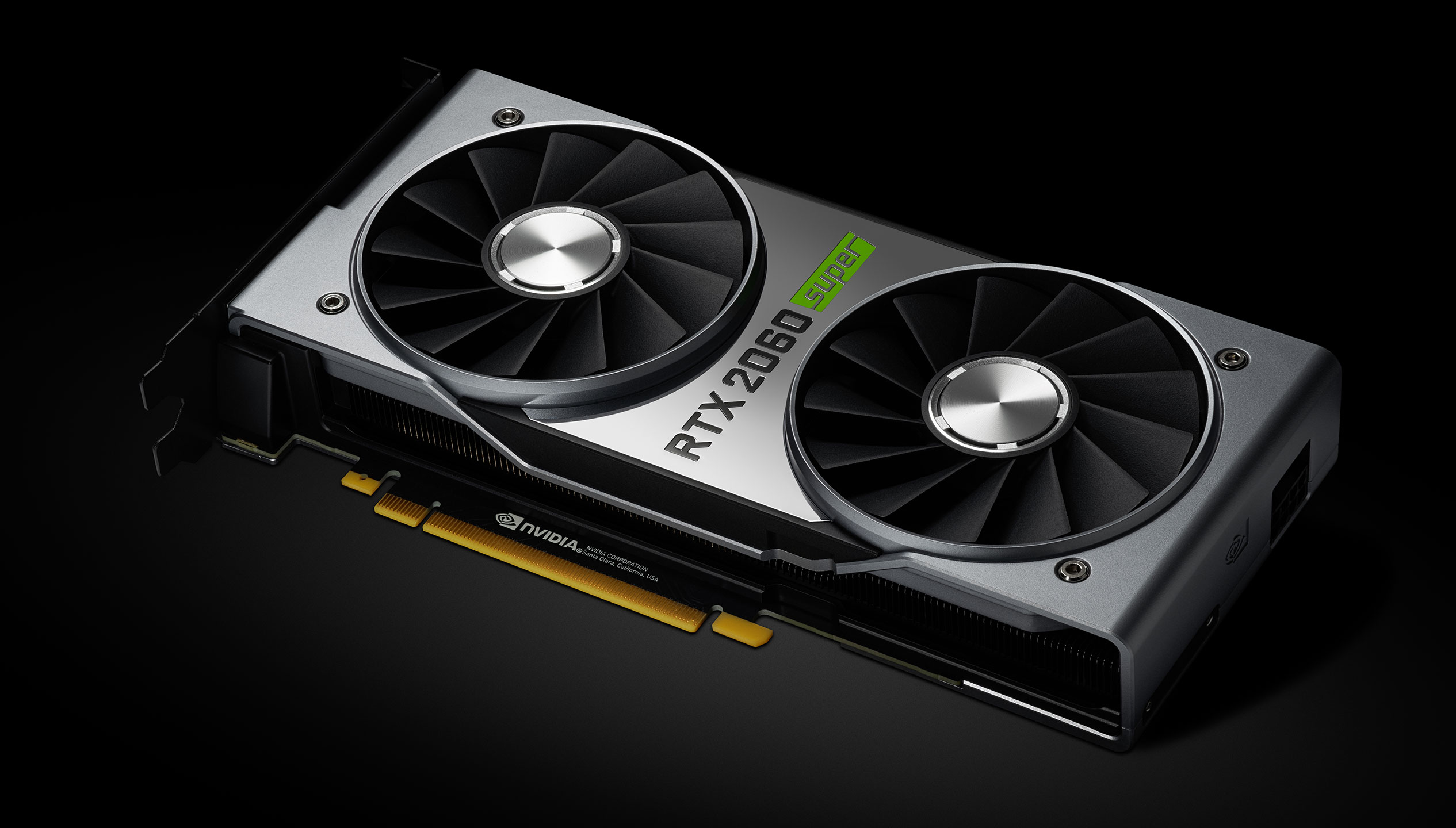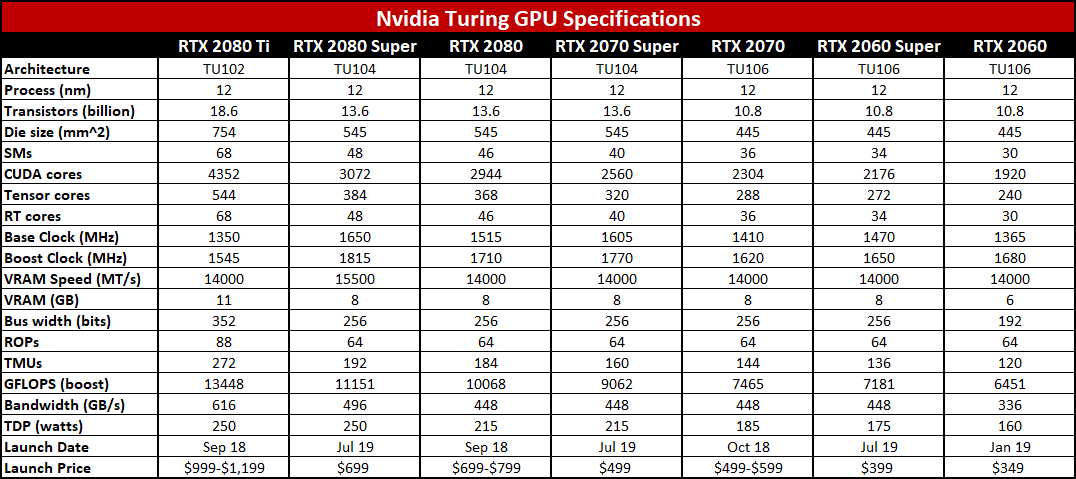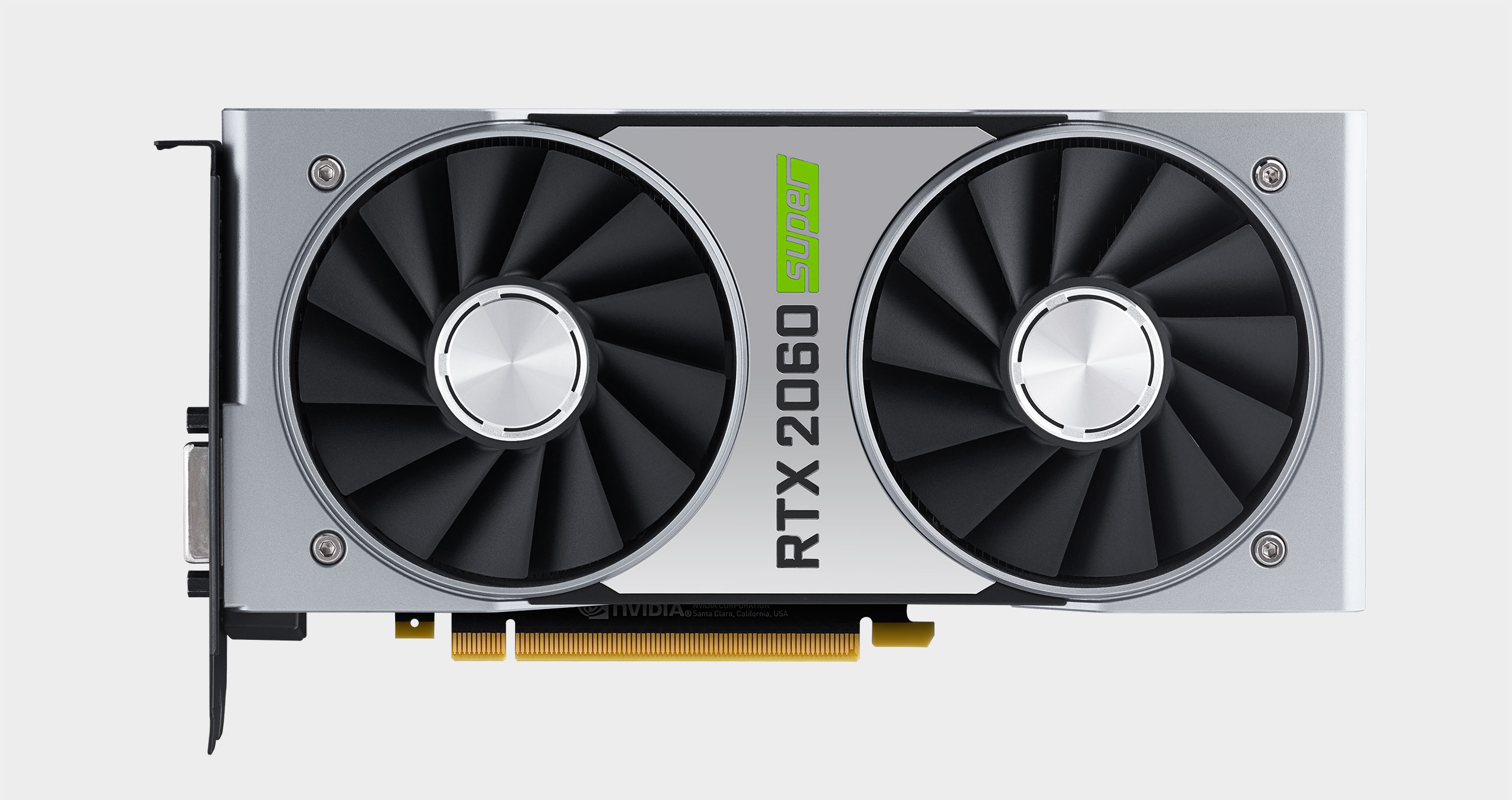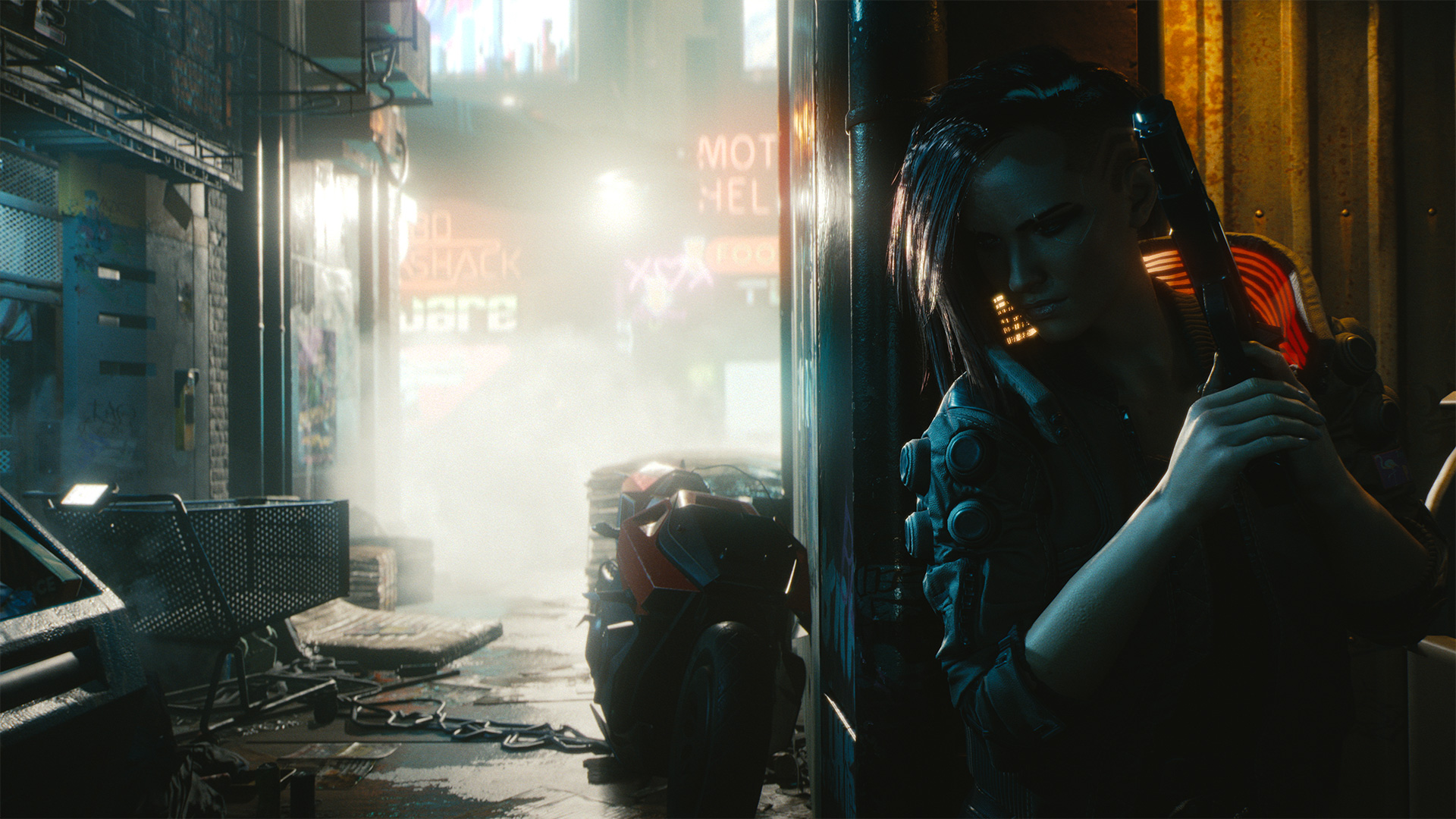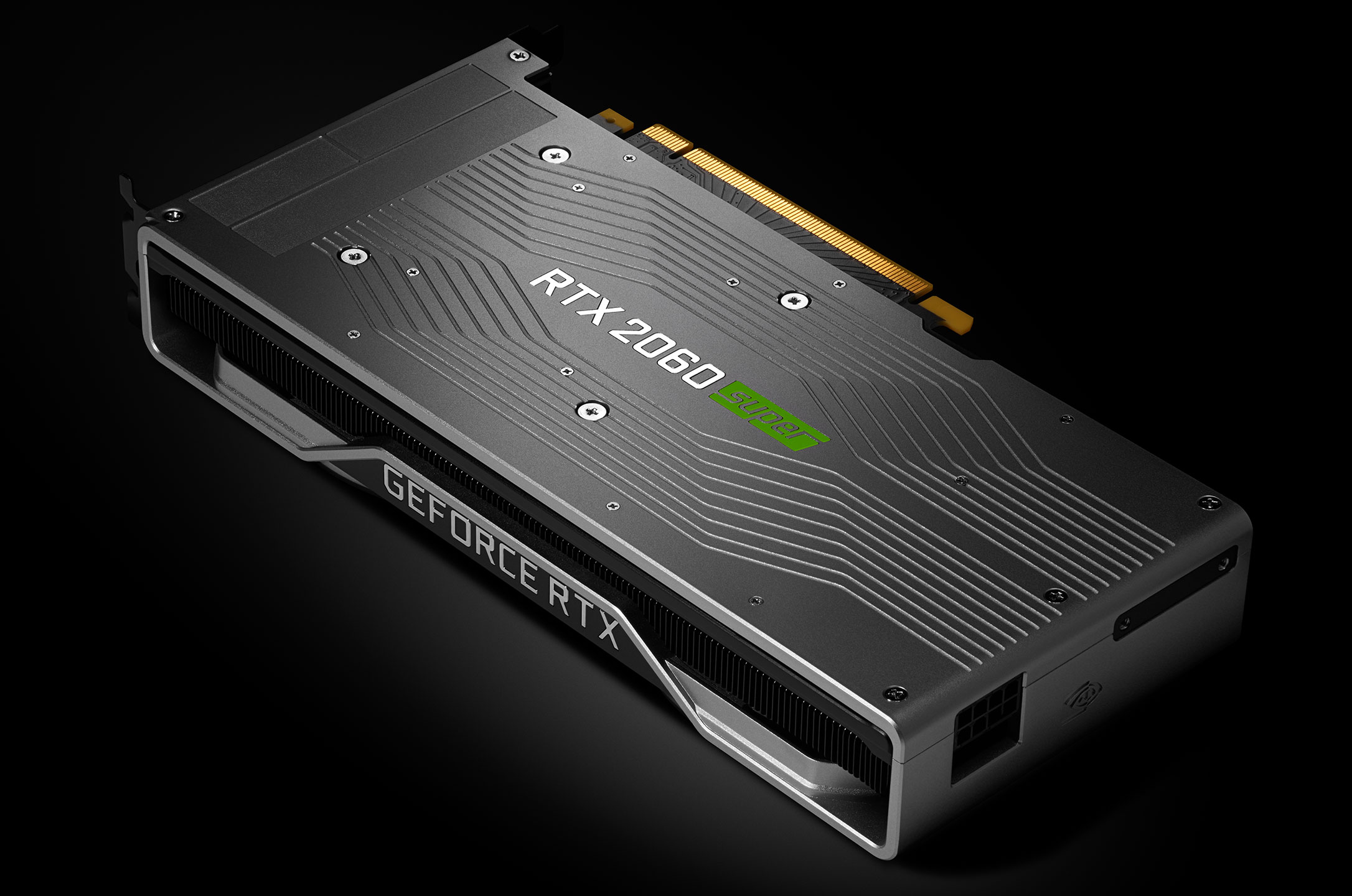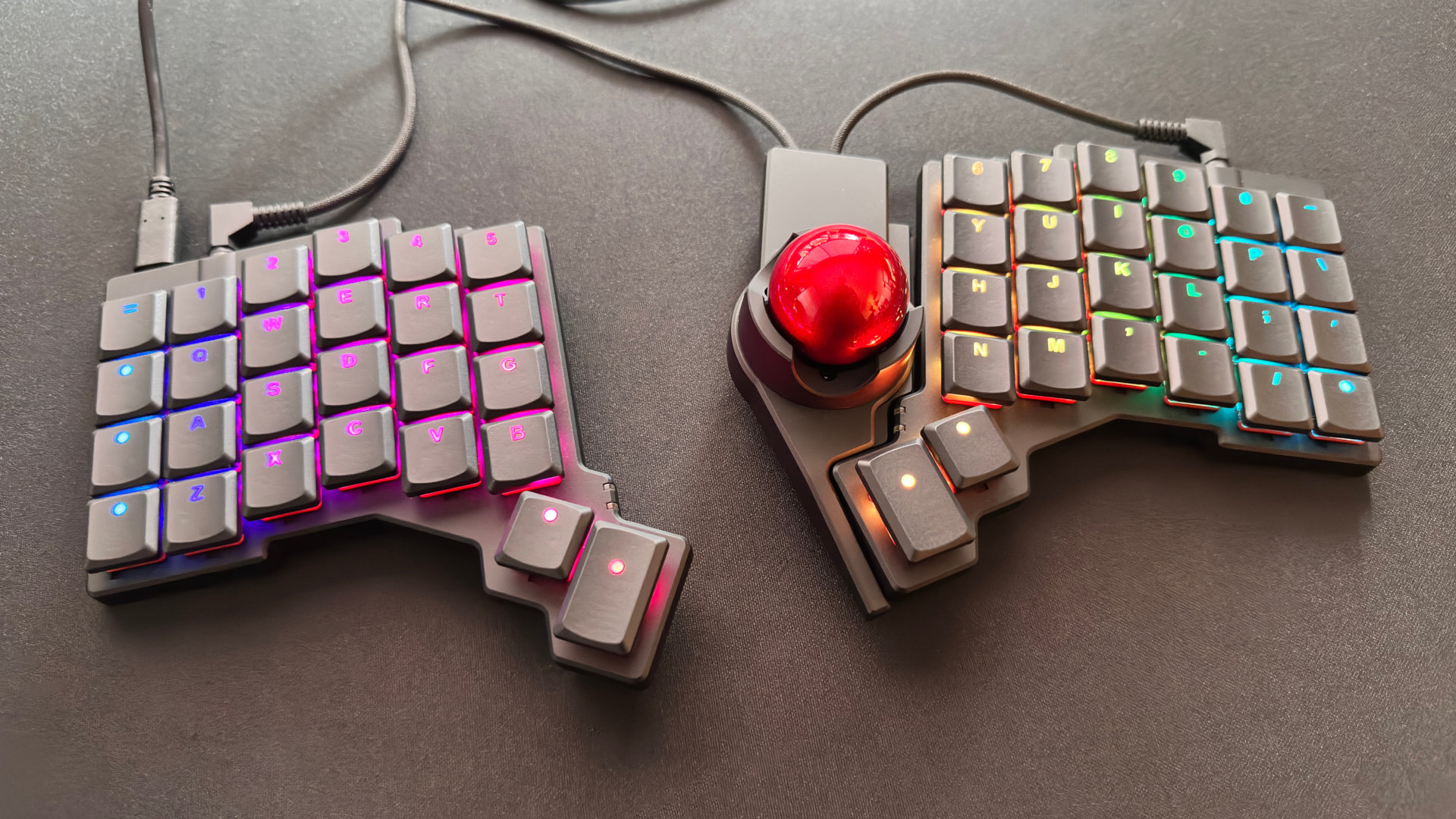Our Verdict
The GeForce RTX 2060 Super is a capable graphics card that nearly matches the performance of the RTX 2070 while shaving $100 off the price.
For
- Good 1080p and 1440p performance
- Better value than other RTX cards
- 8GB GDDR6 beats the vanilla 2060
Against
- Not many ray tracing games
- Didn't inherit the 2060 price
- Super dull name
PC Gamer's got your back
The GeForce RTX 2060 Super comes nearly one year after Nvidia revealed its first GeForce RTX graphics cards. Not coincidentally—at all—AMD is slated to launch its new Radeon RX 5700 and RX 5700 XT cards on July 7. Slated to take on the existing RTX 2060 and RTX 2070, at roughly similar price points, AMD's RX 5700 GPUs and the Navi architecture could potentially close the gap with Nvidia. And so, Nvidia is launching a preemptive strike with the GeForce RTX 2060 Super and RTX 2070 Super, with an RTX 2080 Super coming later this month, all in the interest of staying at the top of the heap when it comes to the best graphics cards.
Let me just get this out of the way: I think the Super branding could quite possibly be one of the dumbest things I've seen in recent years. I'm definitely looking forward to the redundant naming that's bound to come from EVGA: the GeForce RTX 2060 Super SSC (Super Super Clocked)! But complaints about naming aside, we're looking at modestly improved core counts.
This review will focus on the RTX 2060 Super, and Nvidia has provided its Founders Edition model, sporting reference clocks. A separate review covers the GeForce RTX 2070 Super, though it's in these charts as well. Here's what the current RTX lineup looks like with the addition of the 2060 and 2070 Super.
The Turing architecture behind the new Super RTX cards is identical to existing RTX cards. That means the hardware includes RT cores for DirectX Raytracing (DXR) and Vulkan-RT, Tensor cores for DLSS (Deep Learning Super Sampling) and other machine learning workloads, variable rate shading, mesh shaders, and concurrent integer and floating-point execution pipelines. Even if paper specs might not always look like a big jump over the previous generation GTX 10-series cards, the GeForce RTX cards make better use of their hardware.
The 2060 Super uses the same TU106 GPU that's in the RTX 2060 and 2070, but it's closer to the 2070 than the 2060. It has 8GB of GDDR6, which means 33 percent more bandwidth—the same as the 2070 as well as the 2070 Super. The TU106 has up to 36 SMs (Streaming Multiprocessors), and the 2060 Super has 34 enabled. That puts it right between the two previous cards, while the new 2070 Super gets a TU104 GPU with 40 SMs enabled—basically, a small step down from the vanilla RTX 2080.
Clockspeeds are slightly lower than the RTX 2060, but the extra cores and memory should deliver a substantial boost in performance. The RTX 2070 meanwhile still has a few more CUDA cores, and depending on what particular graphics card model you're looking at the clockspeed is either slightly lower or slightly higher than the 2060 Super. For our testing, we're using the Founders Edition models of all the RTX graphics cards, which means the 2070 FE is clocked higher than the 2060 Super (the reference 2070 has a 1620MHz boost clock).
In terms of performance expectations, the RTX 2060 Super should be just a tad slower than the reference RTX 2070, but it should also be quite a big jump in performance over the vanilla RTX 2060. The pricing reflects this, with the new RTX 2060 Super selling for $399 while the RTX 2060 will continue to be sold for $349. That price makes this one of the best graphics cards in terms of value. The new RTX 2070 Super meanwhile takes over the $499 price point—and that includes the Founders Edition model.
Keep up to date with the most important stories and the best deals, as picked by the PC Gamer team.
Our gaming benchmarks continue to use a Core i7-8700K overclocked to 5.0GHz to ensure the CPU isn't a bottleneck in our testing. We also use DDR4-3200 memory and fast SSD storage. We've benchmarked using the latest drivers available at the time of testing, including retesting older GPUs to ensure our results are up to date. All Nvidia GPUs were tested with the 430.86 drivers, except for the two Super cards which used 431.16 (because there's simply not enough hours in the day to retest every GPU with the launch drivers Nvidia provided). For AMD, we used 19.16.2.
We've also updated our gaming benchmarks since last year, though for purposes of this review we're not enabling ray tracing in any of the games—AMD doesn't have any support for DXR (DirectX Raytracing) or Vulkan-RT right now, and probably won't until next year. The same goes for testing with DLSS. We have looked at ray tracing (and DLSS) performance in the major games already and will continue to do so as new games arrive, but we want to show apples-to-apples comparisons for our graphics card reviews.
That doesn't mean ray tracing support doesn't matter. Over the past ten months we've seen three major games deliver ray tracing support (Battlefield V, Metro Exodus, and Shadow of the Tomb Raider), plus there's Quake 2 RTX and the Korean MMO Justice, and more games are coming. Wolfenstein: Youngblood will be the next one at the end of this month, with Control in August, Mechwarrior 5 Mercenaries in September, Call of Duty: Modern Warfare in October, and Doom Eternal in November.
Are any of those games important enough to want an RTX card? Perhaps, perhaps not. Looking to 2020, Vampire: the Masquerade—Bloodlines 2 and Cyberpunk 2077 next year are certainly higher up my list of games I'm excited to play, and there's also Watch Dogs: Legion, Atomic Heart, and more. The current handful of games that support ray tracing hardware nine months after software support arrived might not seem like much, but for the record, there are already more games using DXR less than one year after its release than there were games using DX12 one year after it became available.
For our GPU benchmarks, we have 11 games that we're currently testing, including a pretty even mix of AMD and Nvidia promoted titles. DirectX 12 is utilized in most cases, with the exception of Total War: Warhammer where the "DX12 Beta" performance is particularly weak on Nvidia GPUs. Some of Nvidia's previous generation GPUs like the GTX 970 and GTX 1060 3GB are also tested with DX11 in a few games, as DX12 tends to work best with Nvidia GPUs that have more than 4GB VRAM.
Each card is tested at four settings: 1080p medium (or equivalent) and 1080p/1440p/4k ultra (unless otherwise noted). Every setting is tested multiple times to ensure the consistency of the results, and we use the best score. Minimum FPS is calculated by summing all frametimes above the 97 percentile and dividing by the number of frames, so that it gives a reasonable representation of the lower end of the performance scale, rather than looking only at the single worst framerate from a benchmark run. Here are the results, starting with 1080p. The RTX 2060 Super works best as a card for 1080p or 1440p gaming. 4K is often possible at lower quality settings (or with DLSS), but more demanding games like Metro tend to be a bit out of reach.
GeForce RTX 2060 Super performance
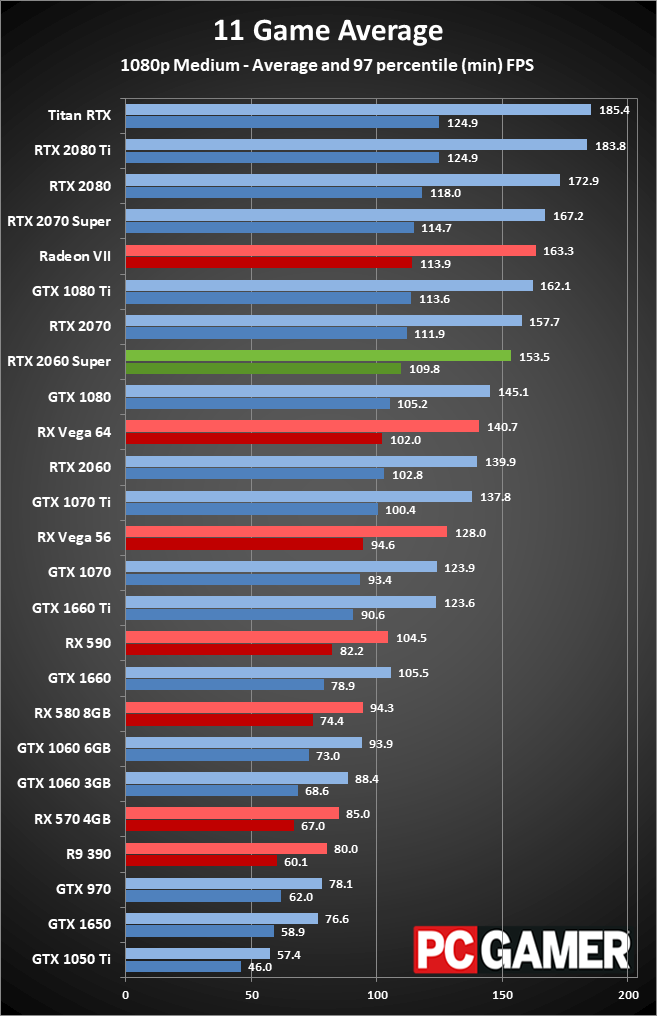
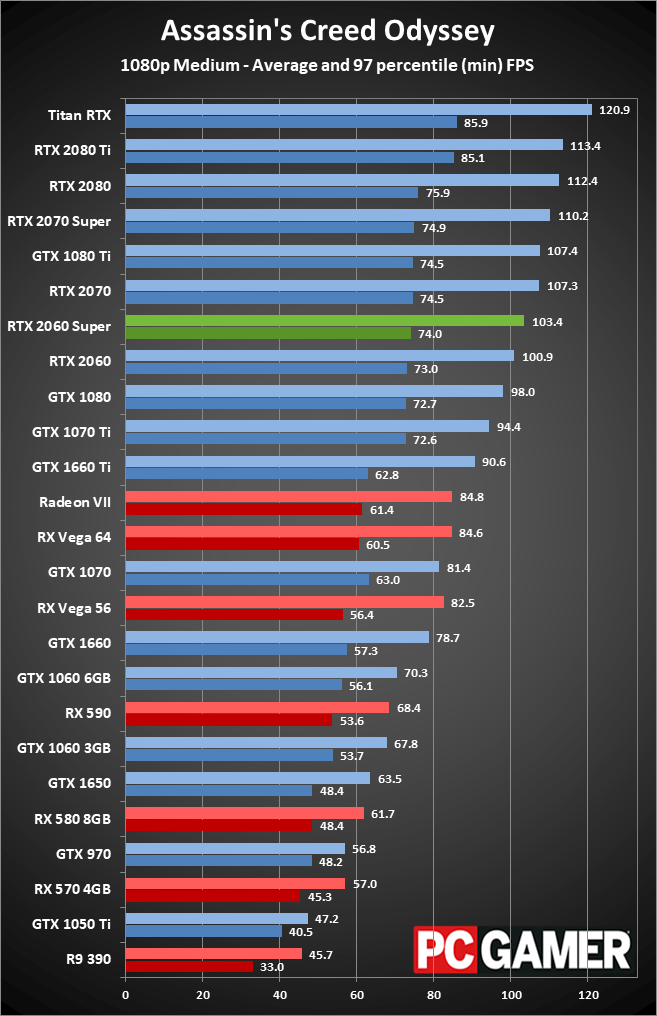
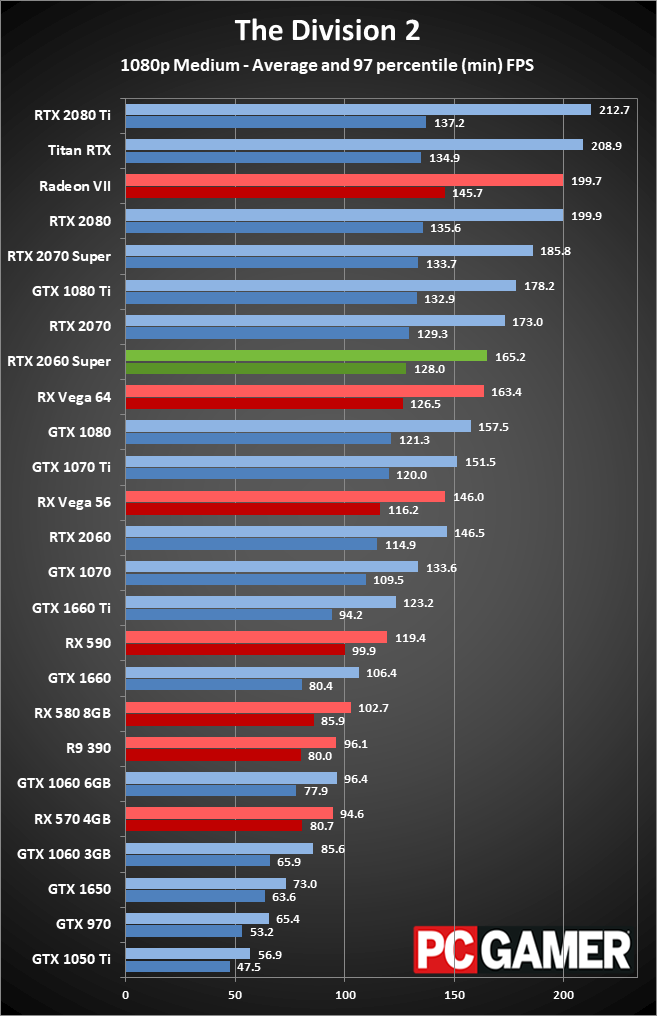
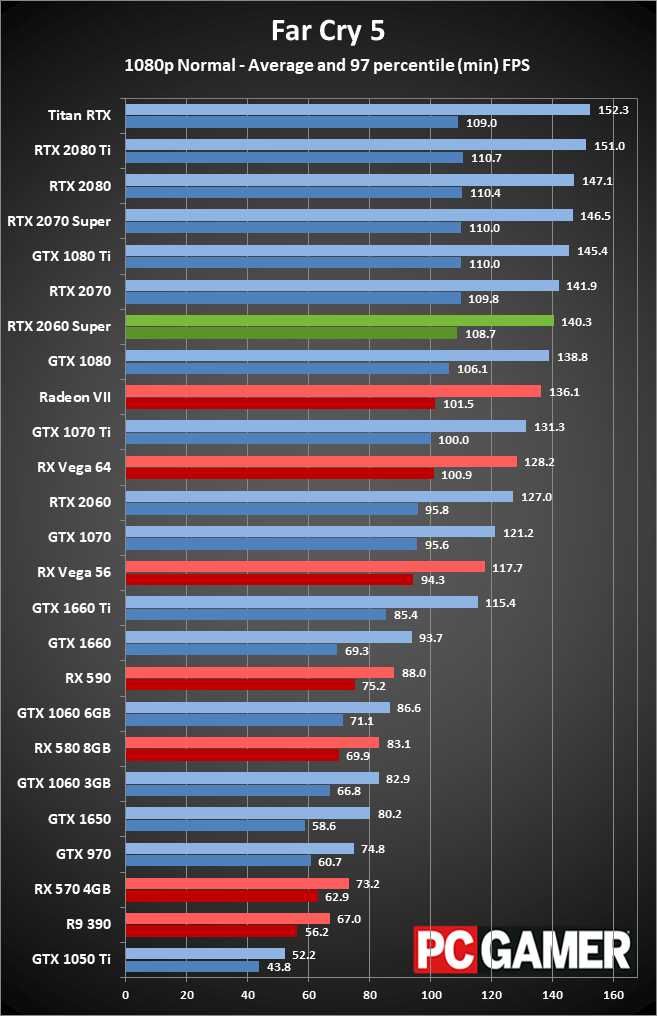
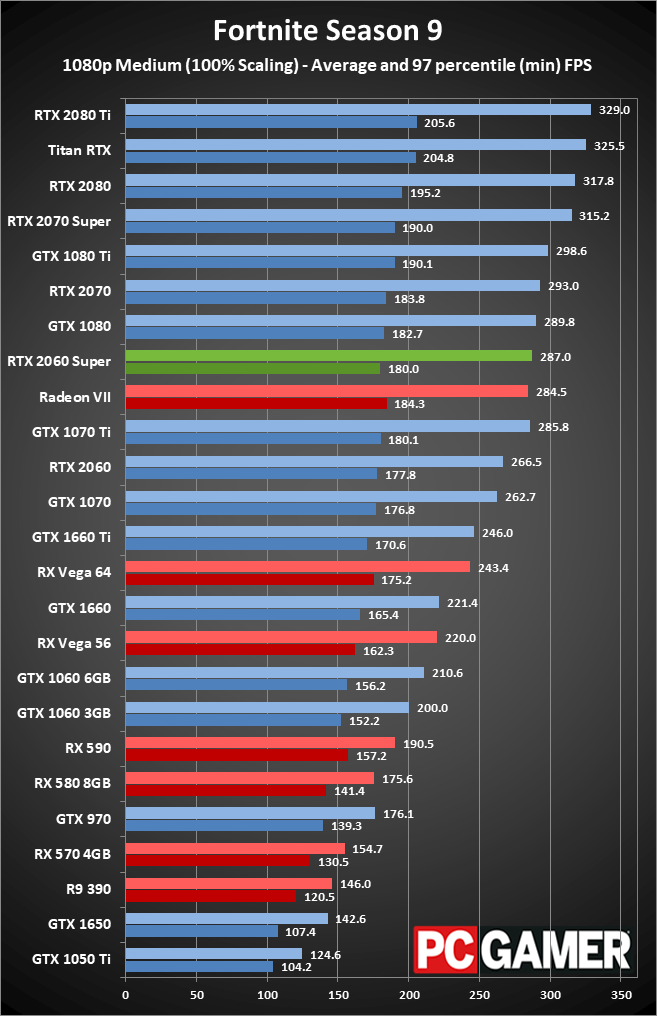
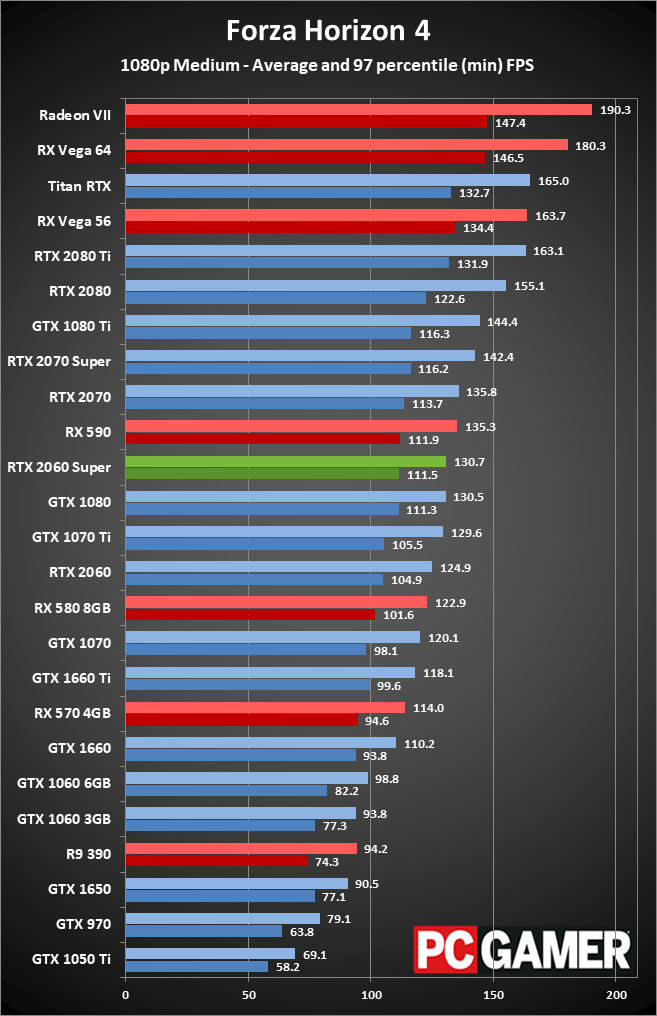
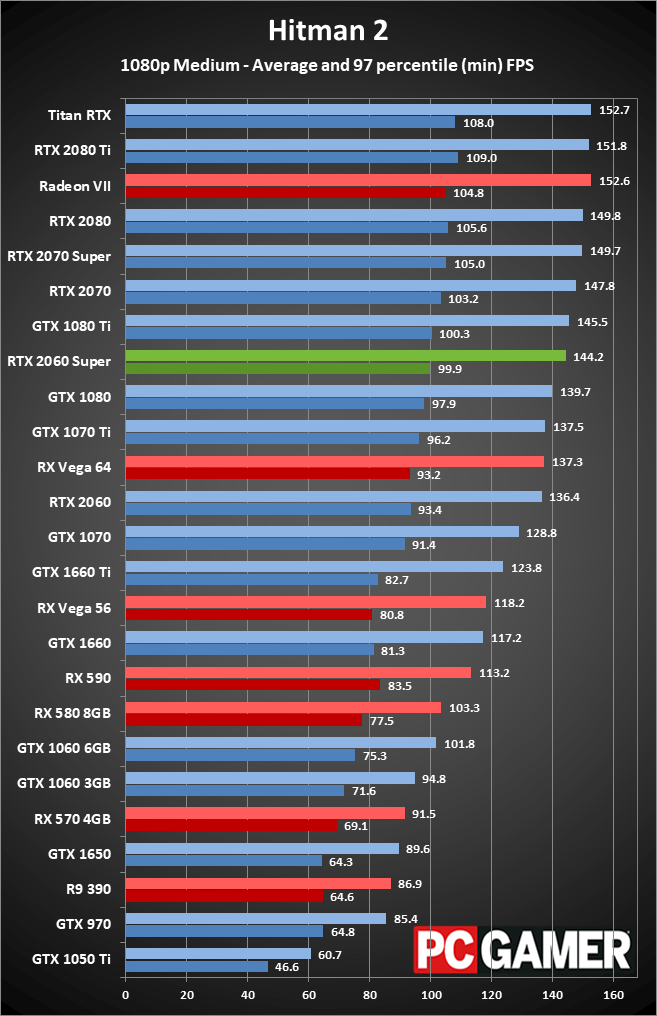
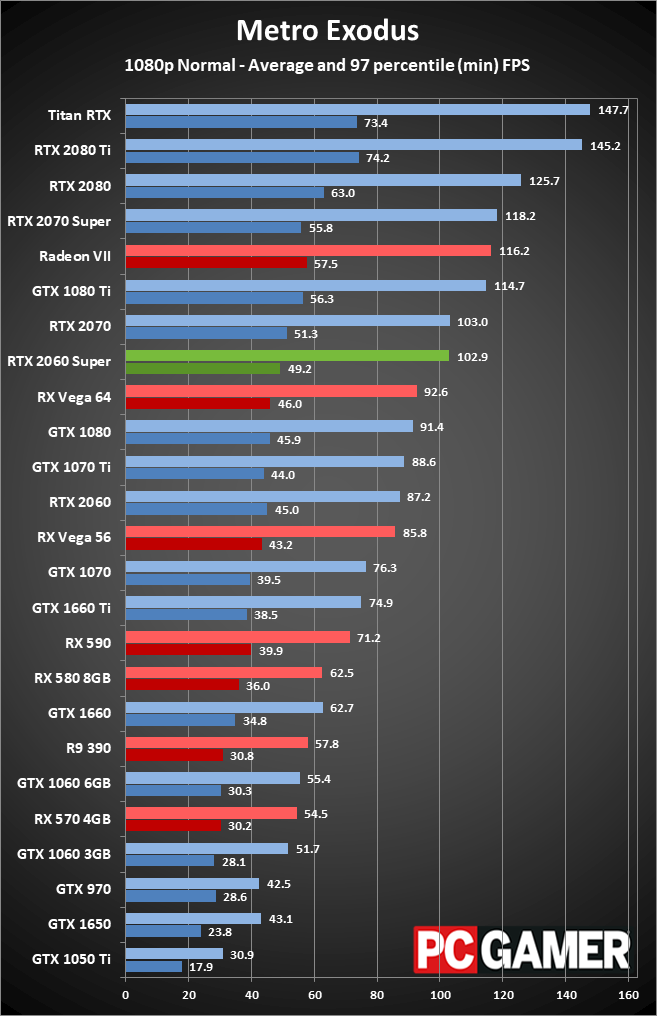
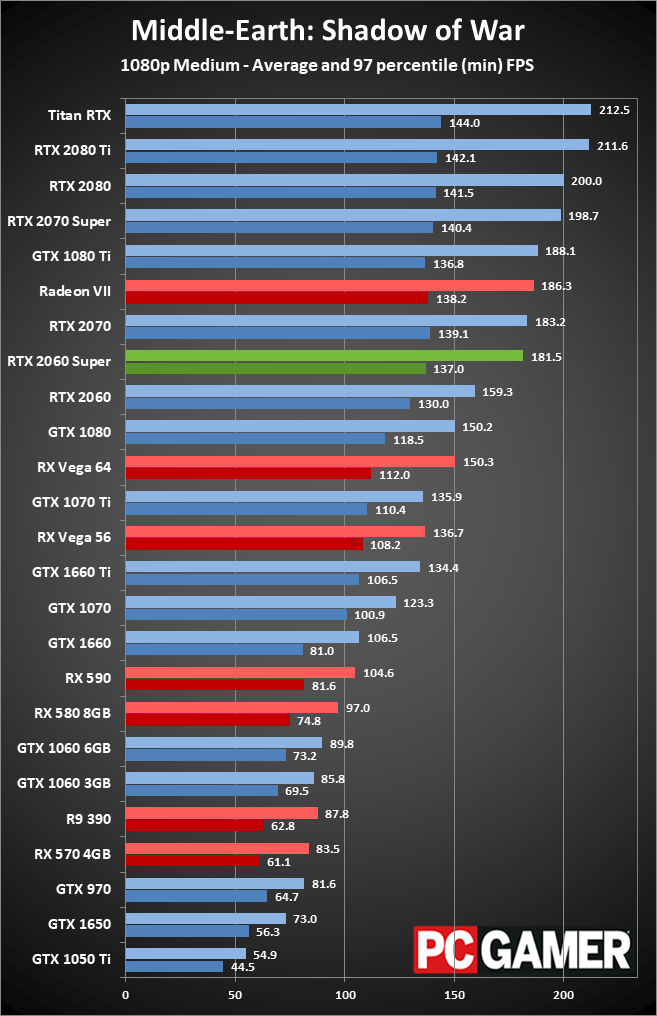
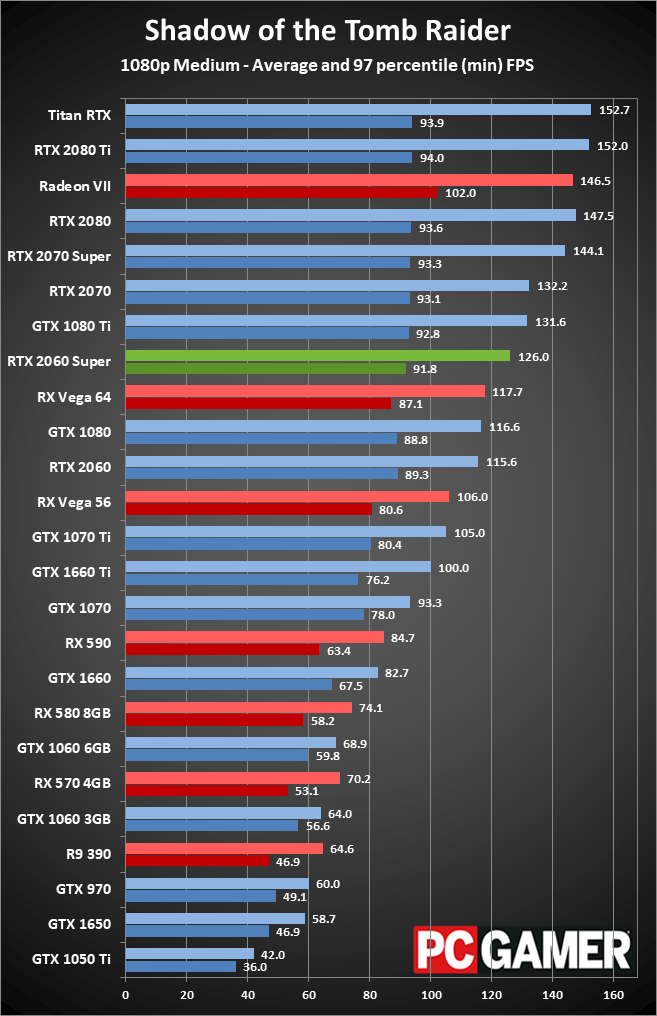
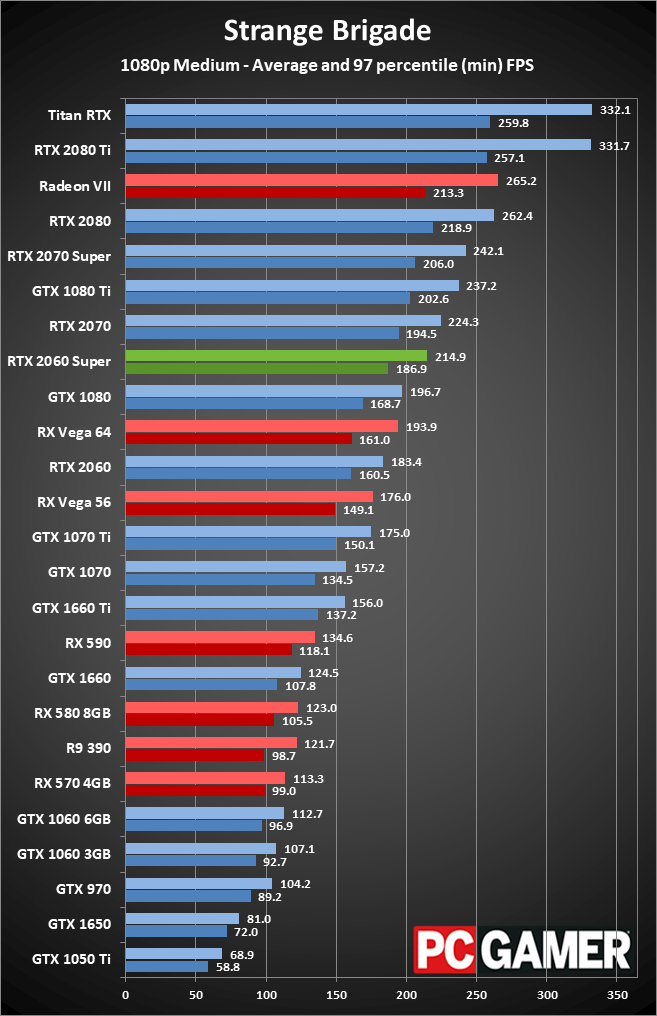
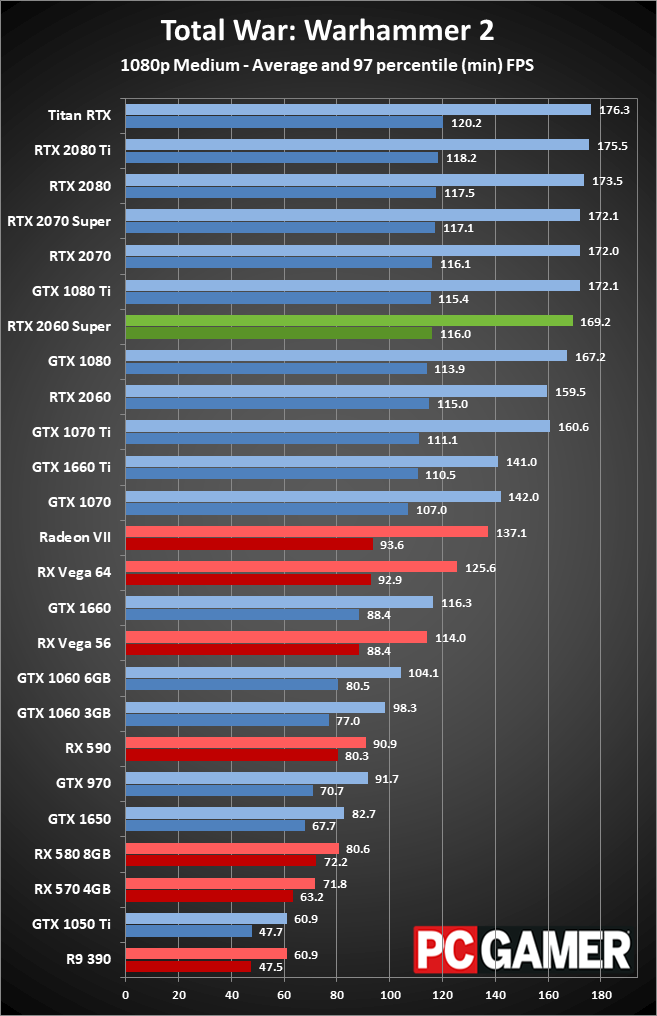
1080p medium might seem like an awfully low bar to clear for a $400 graphics card, but keep in mind that ultra-responsive 144Hz gaming often requires lower the resolution and settings even with high-end hardware. Most of the games in our test suite get there, though the most demanding games (Assassin's Creed Odyssey, Metro Exodus, and Shadow of the Tomb Raider) fall well short.
Overall, performance is right where you'd expect it to be based on the specs. The RTX 2060 Super outperforms the RTX 2060 by 10 percent and nearly matches the RTX 2070.
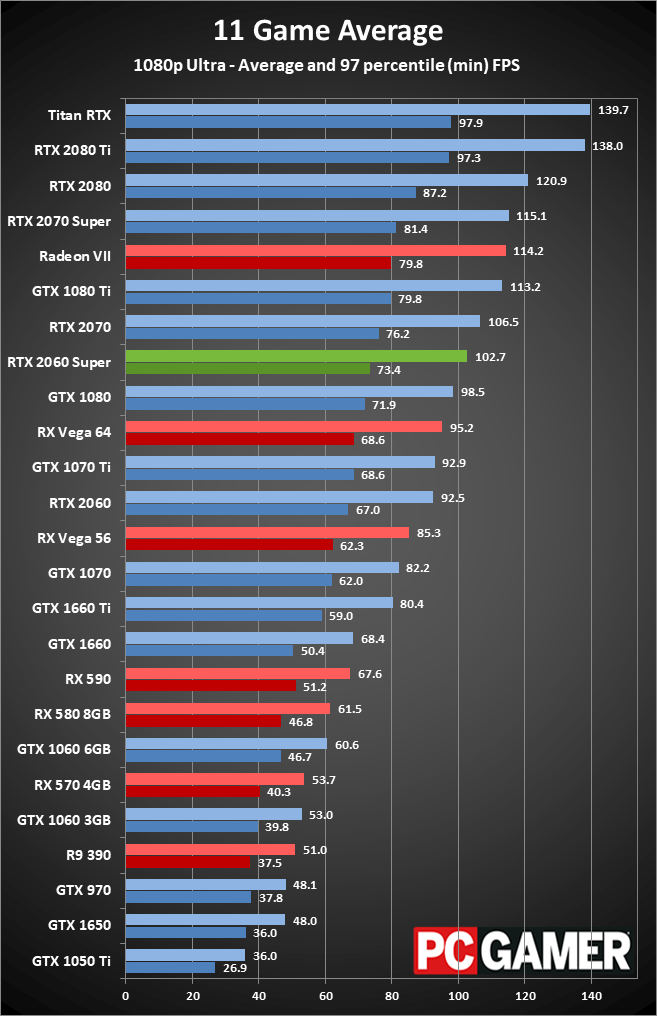
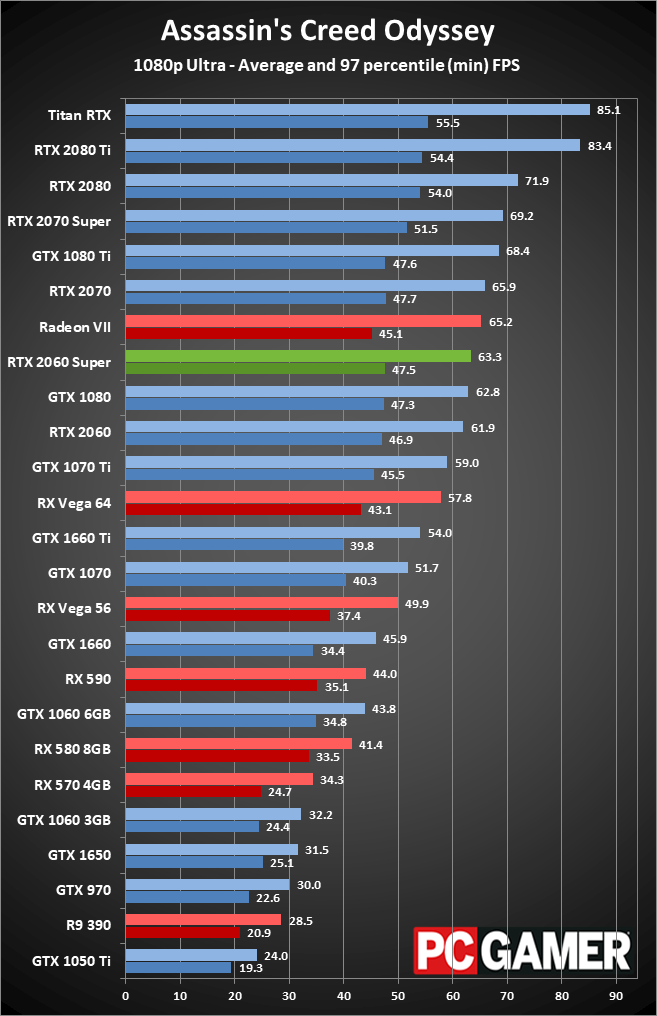
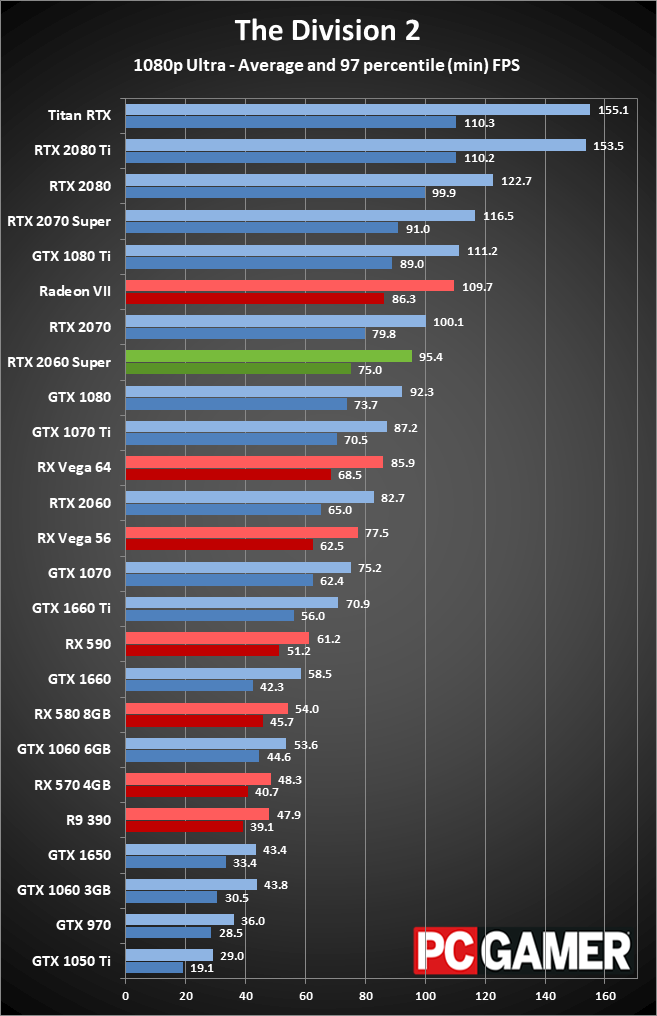
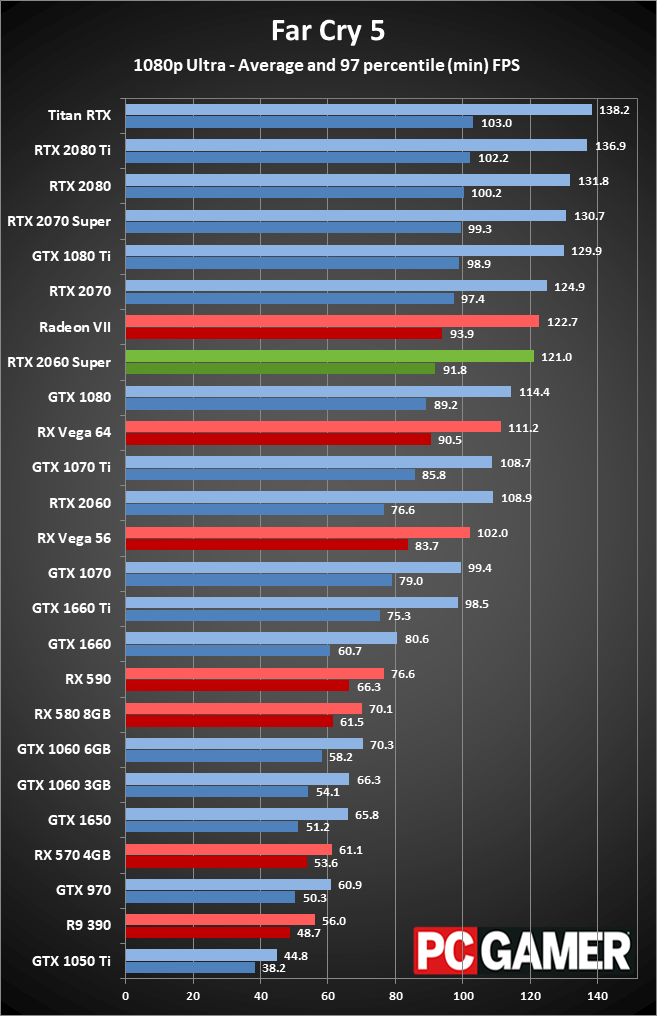
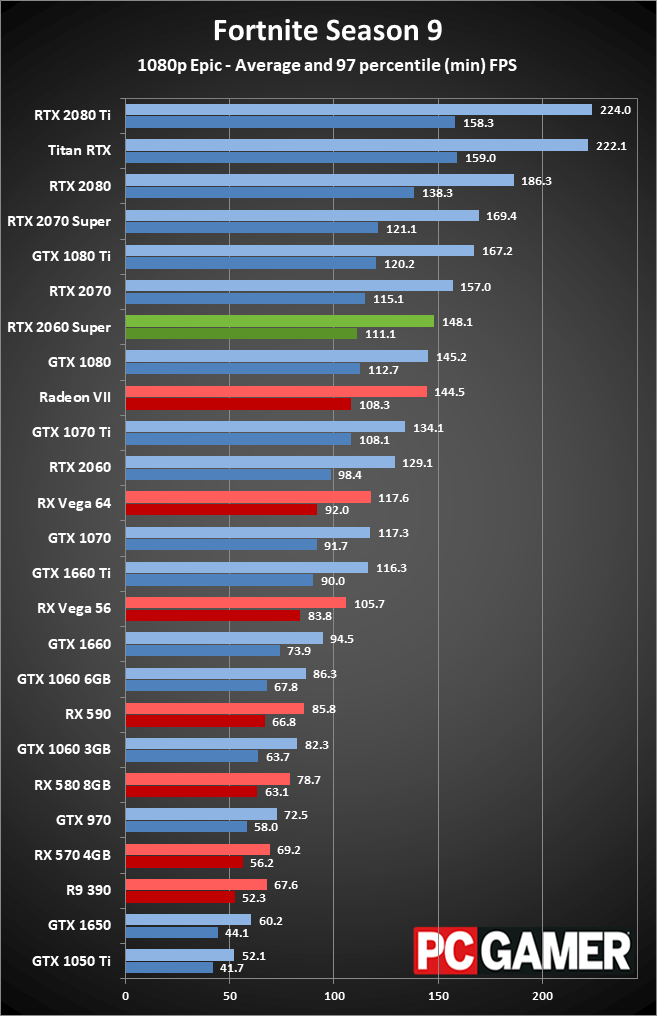
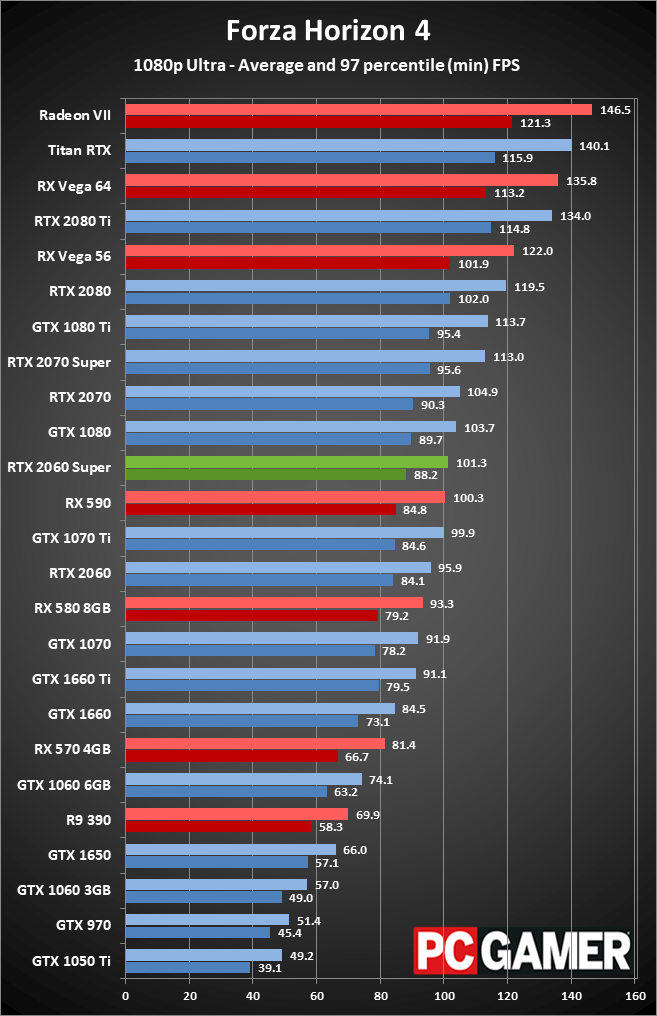
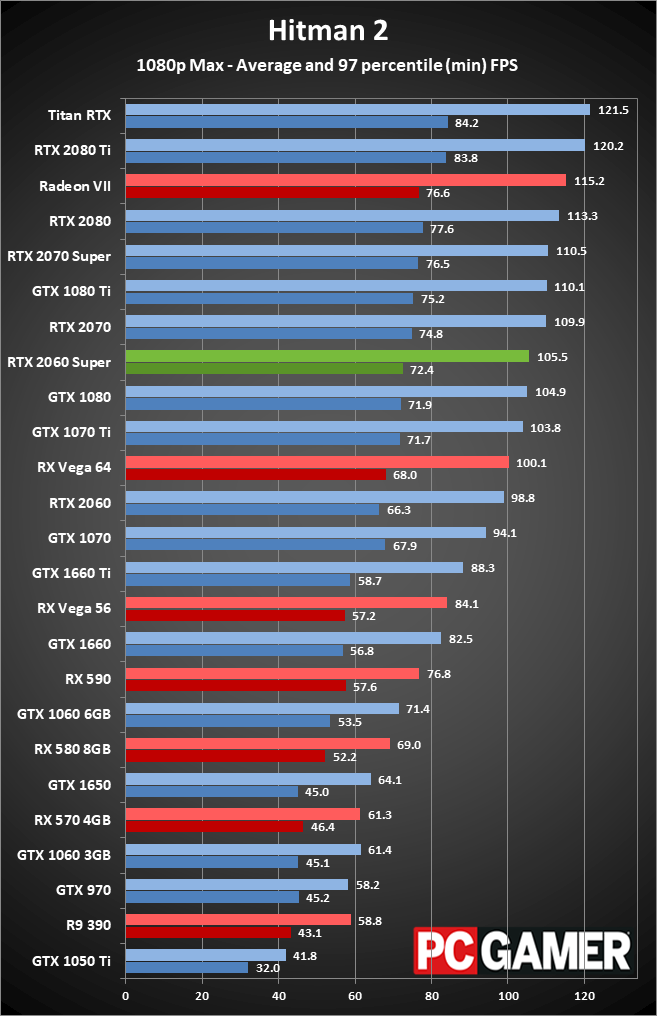
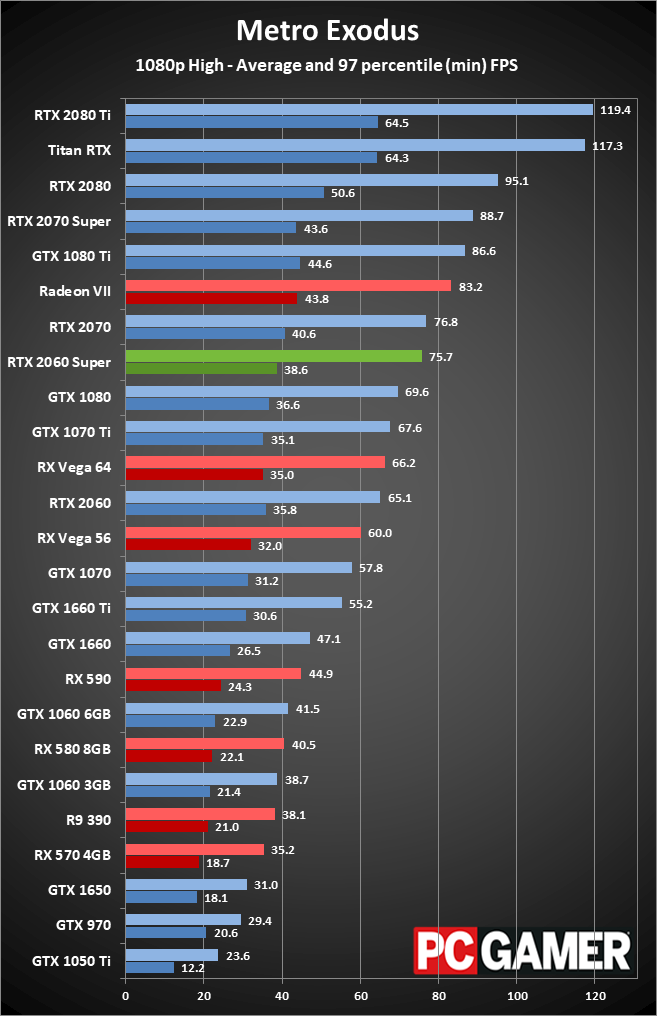
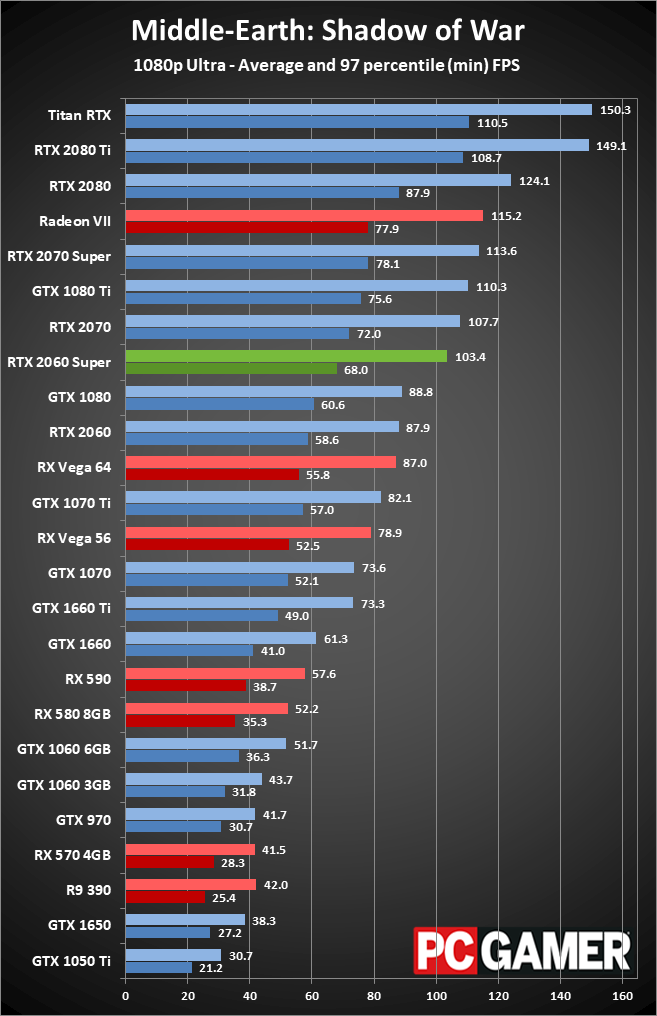
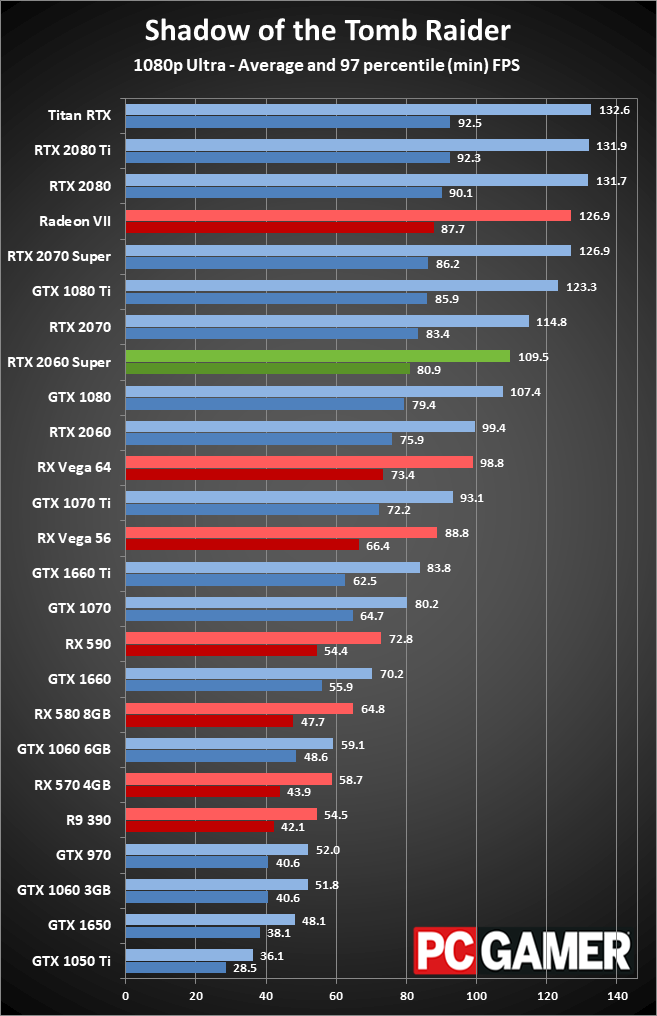
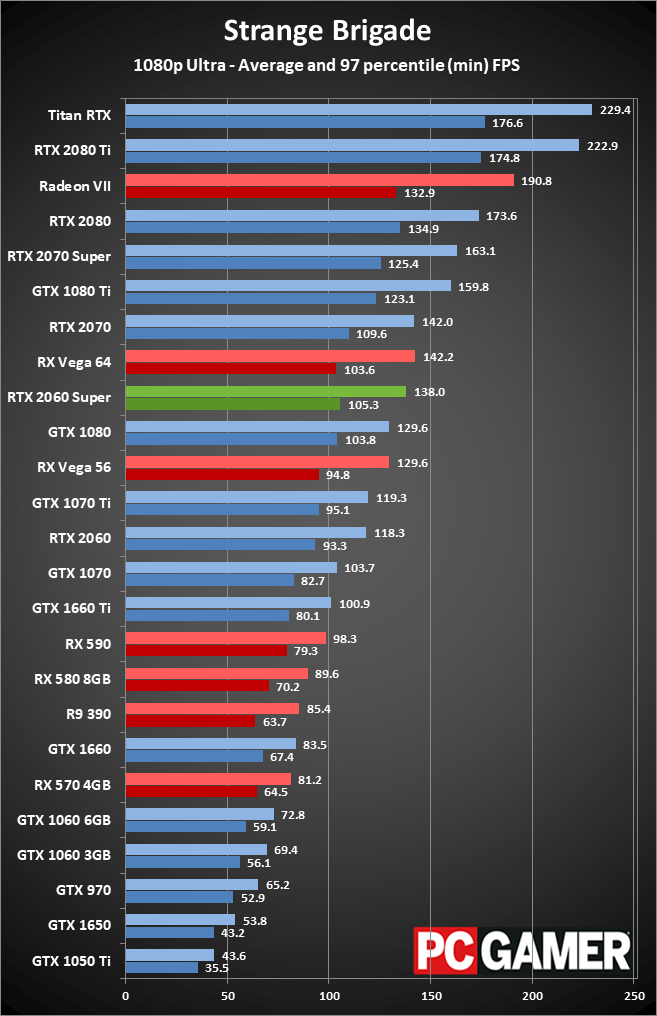
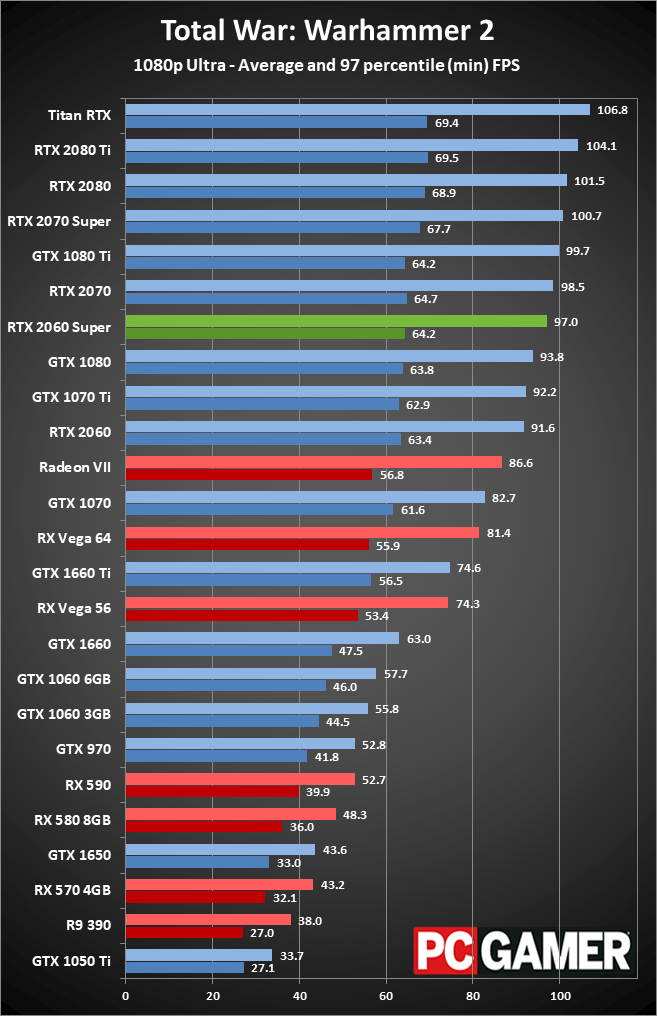
1080p ultra at 60fps or more typically isn't a problem with any of the high-end graphics cards, but if you own a 144Hz display only one of the 11 games tested actually breaks 144fps (Fortnite). All of the games still average 60fps or more, though Metro Exodus is tested using the high preset (not that the ultra preset really looks all that different considering the drop in framerate).
Again, the 2060 Super is a nice 11 percent performance upgrade over the vanilla 2060. Looking at the Vega 56 and 64, AMD's upcoming RX 5700 and 5700 XT now have a new target to hit. We'll find out on July 7 exactly how AMD does against the new GPU landscape.
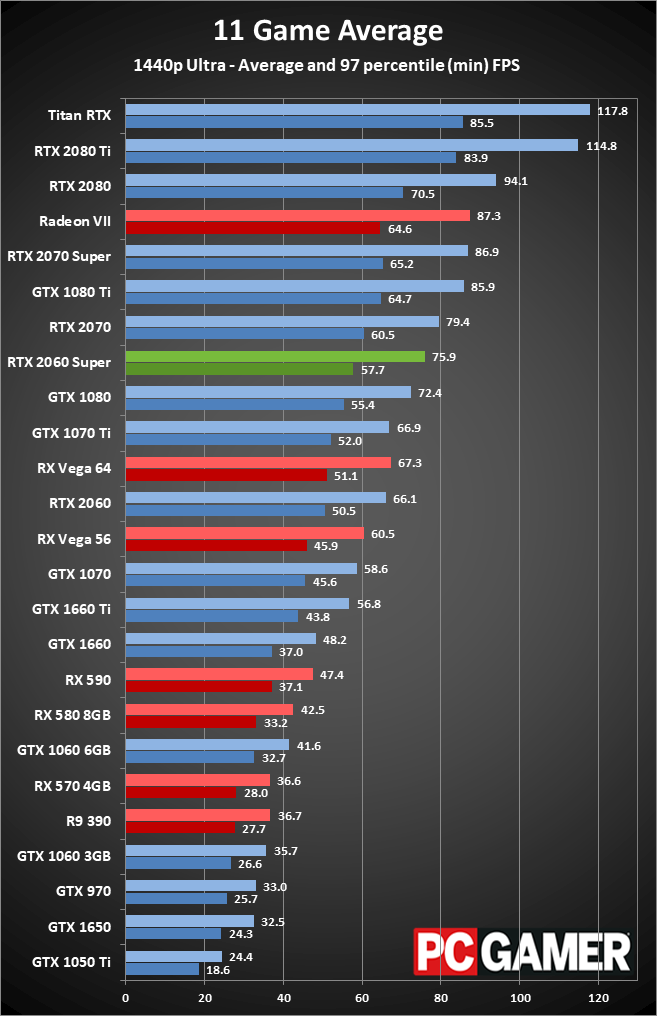
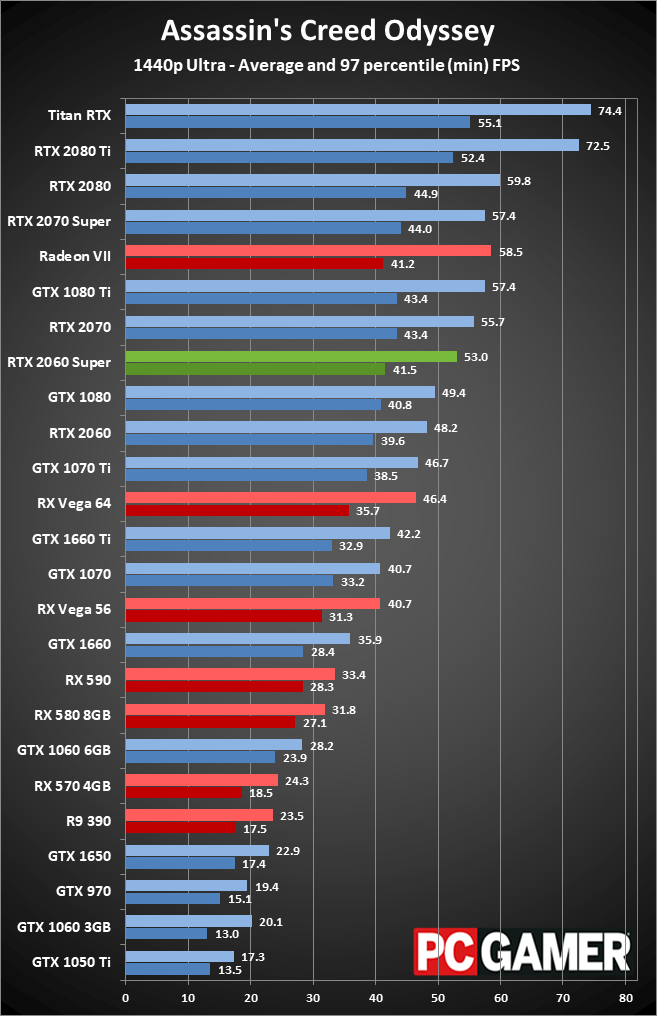
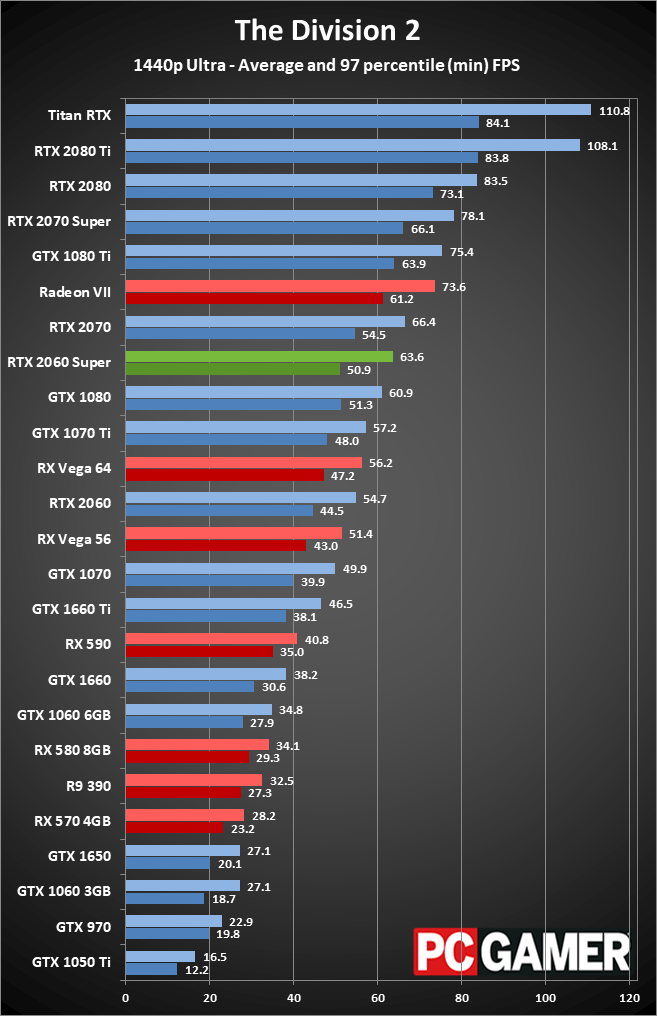
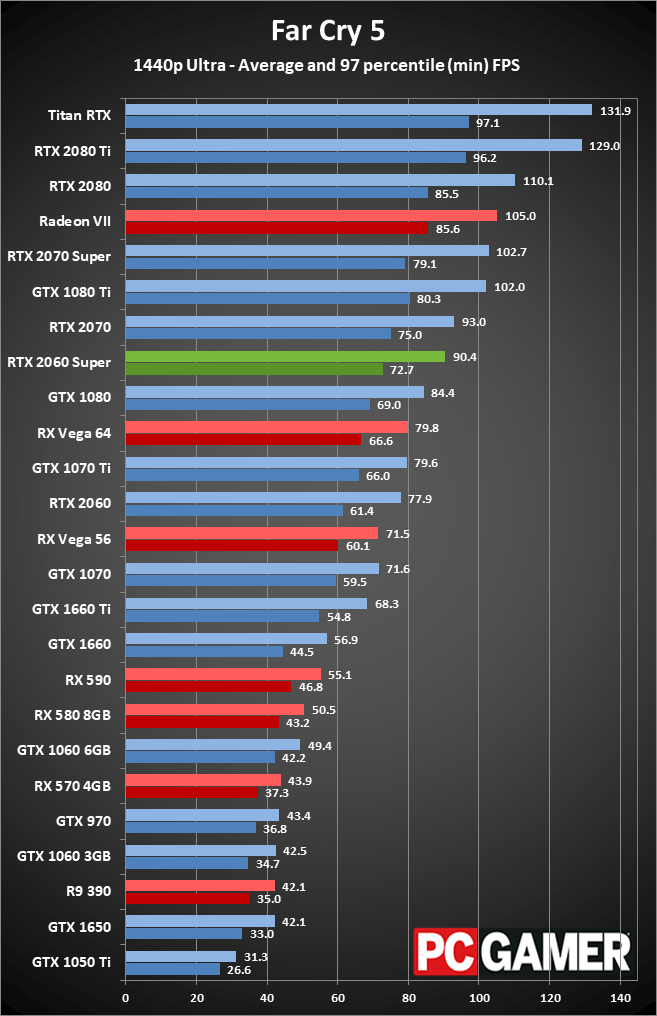
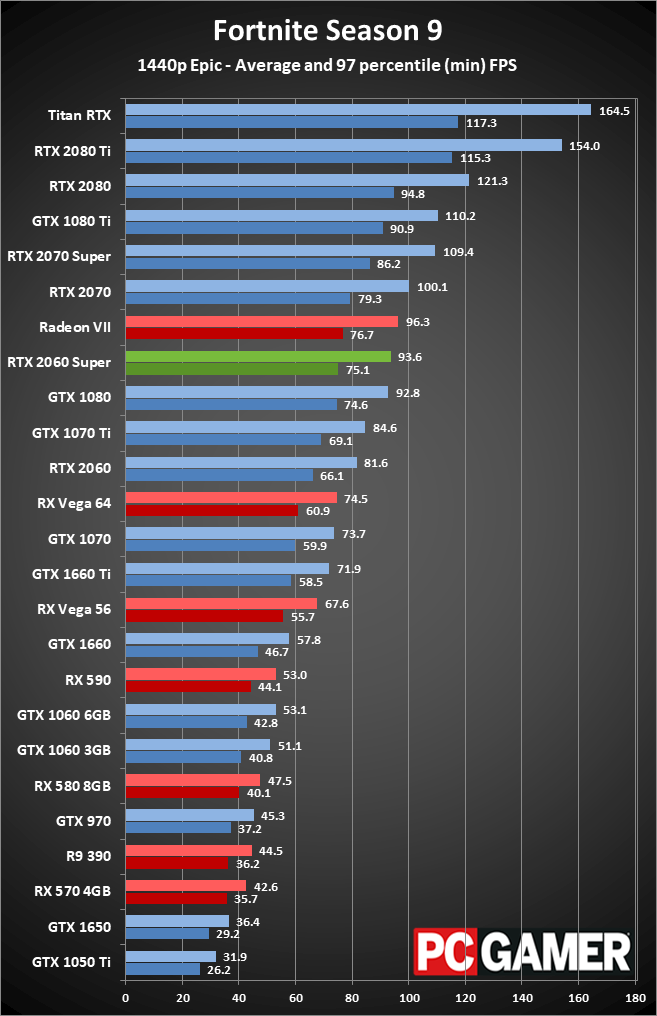
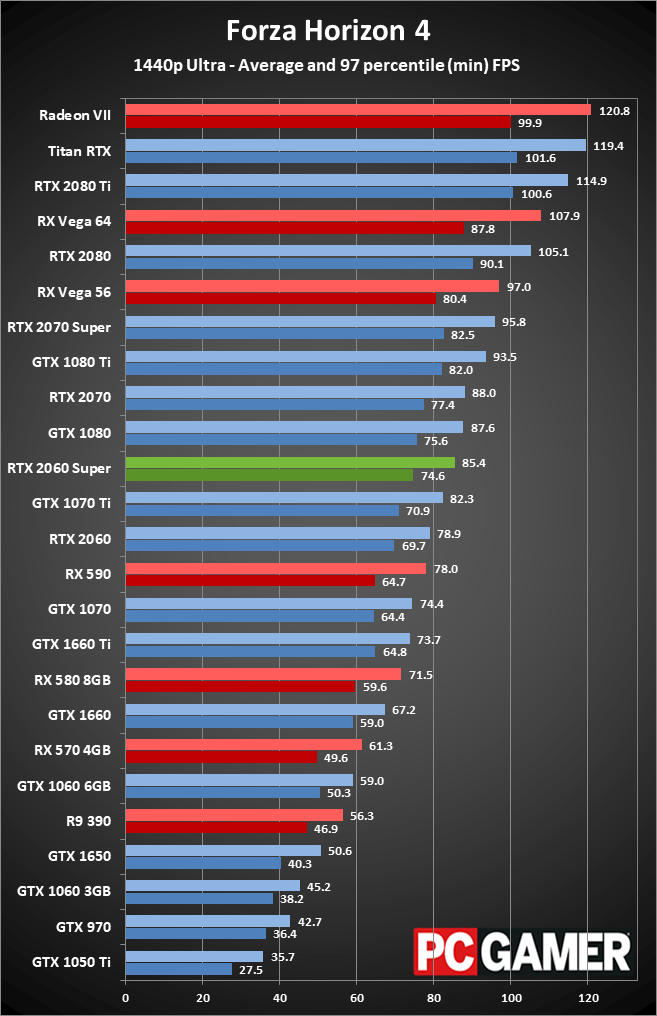
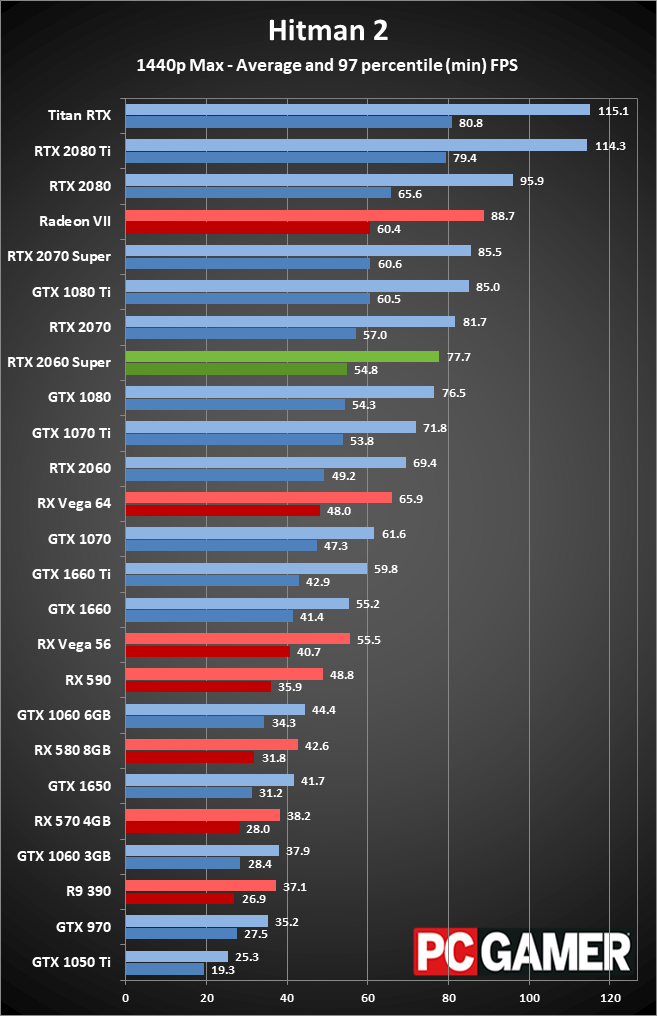
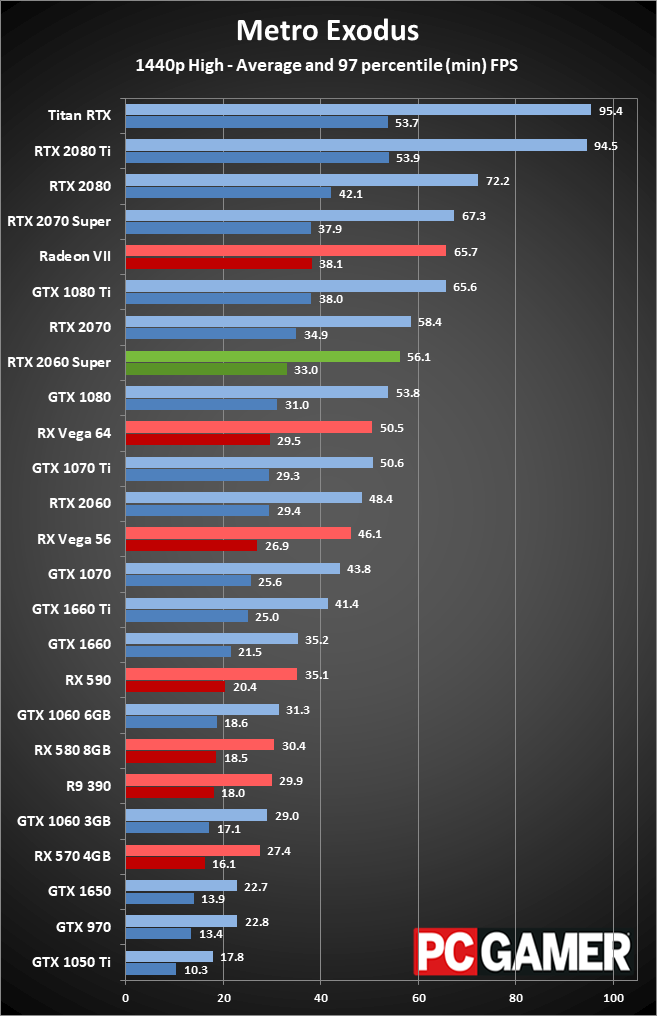
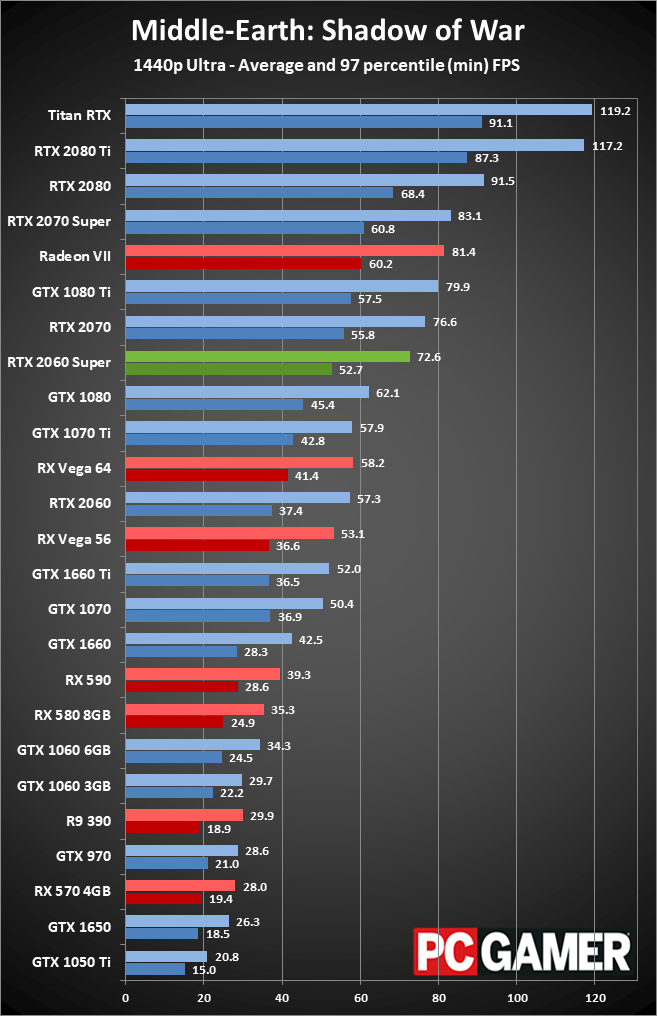
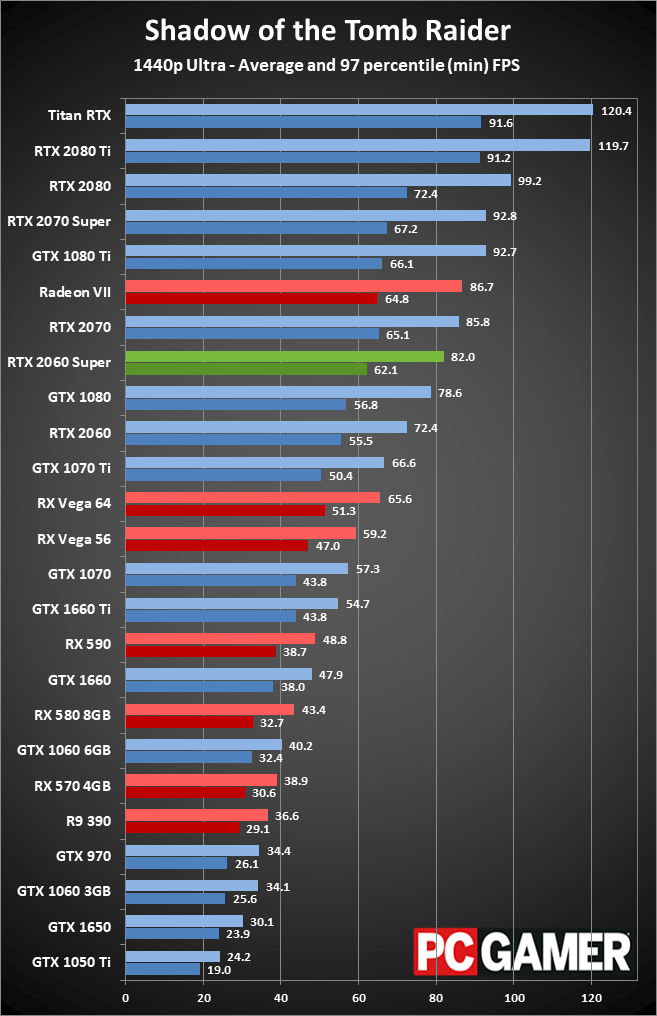
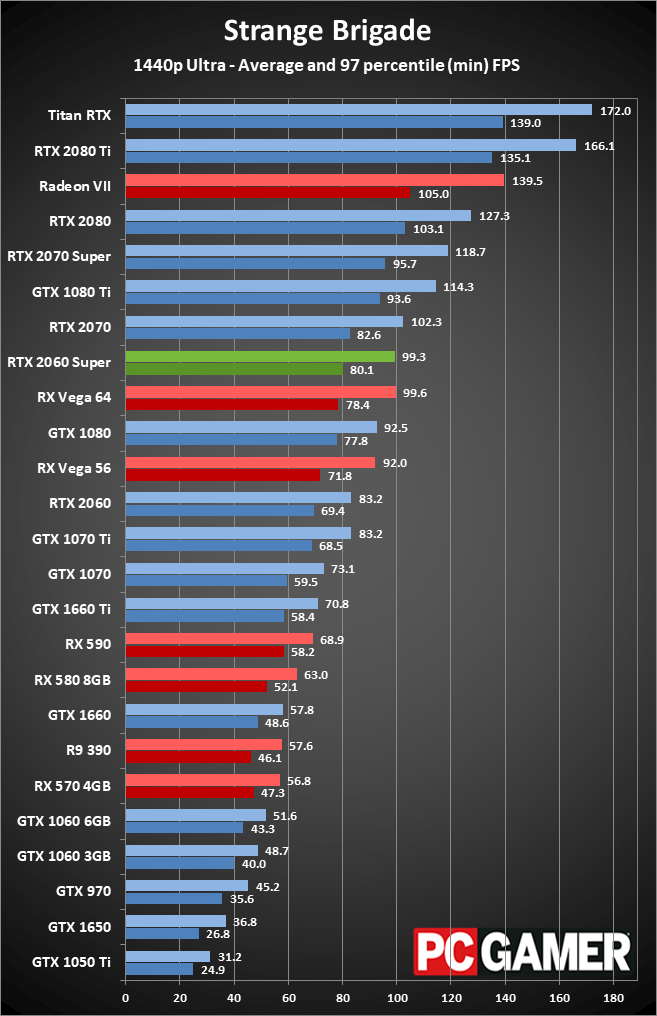
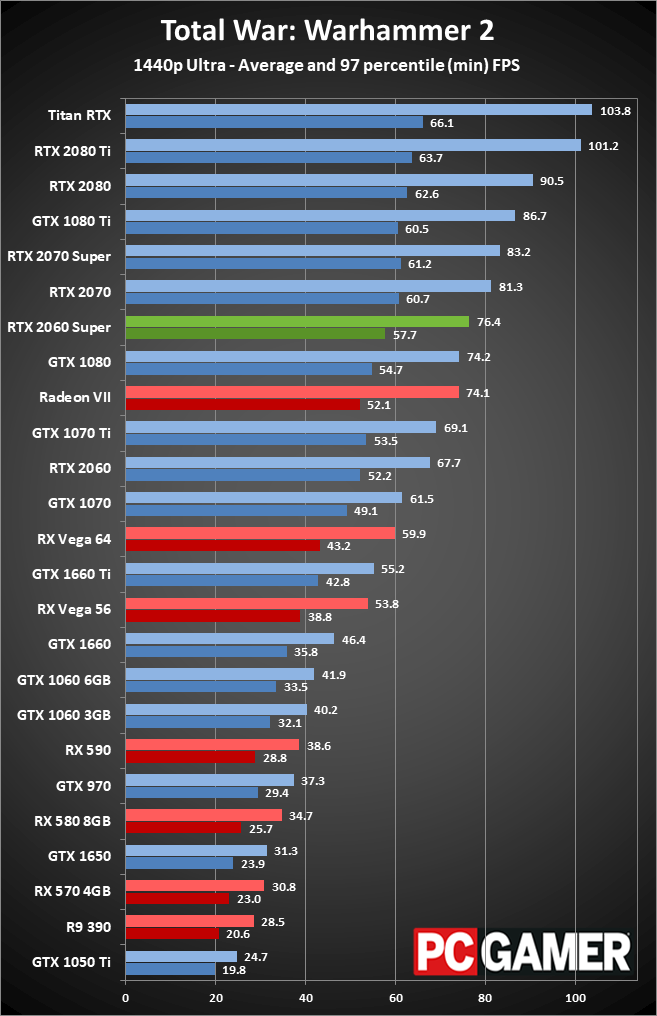
Nvidia pitches the RTX 2060 Super as a graphics card built for 1440p gaming, and provided we're talking about 60fps it does generally succeed. A couple of games (Assassin's Creed and Metro Exodus) don't average 60fps or more, but tweaking the settings can get there.
With the higher resolution, the added memory bandwidth thanks to the additional 2GB of GDDR6 start to show up more when comparing the 2060 Super with the regular RTX 2060. Now the gap is 15 percent on average, with a few games showing even larger gains.
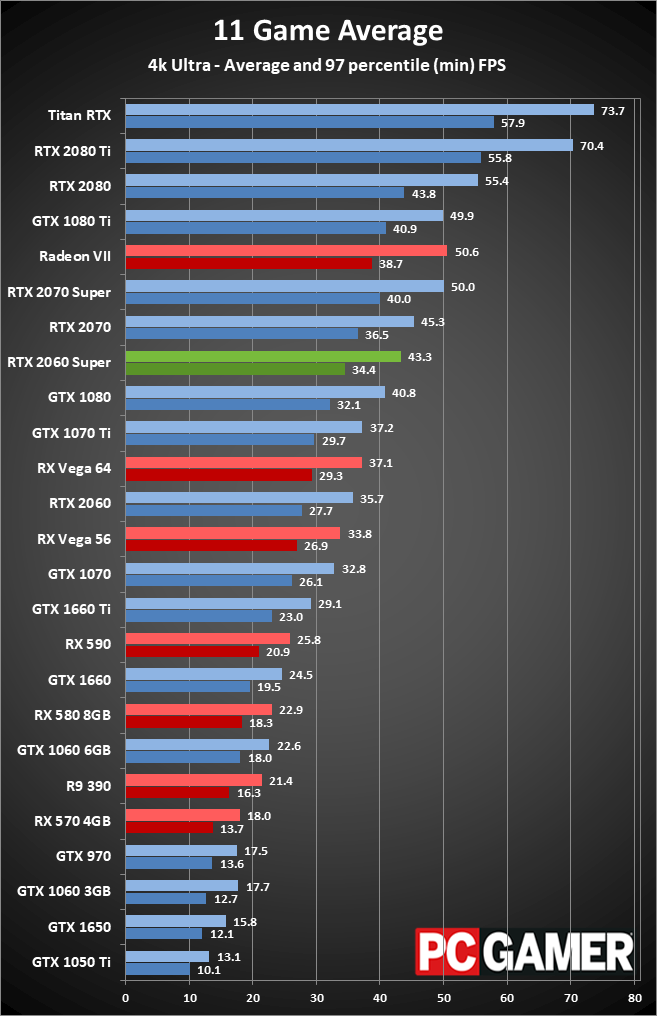
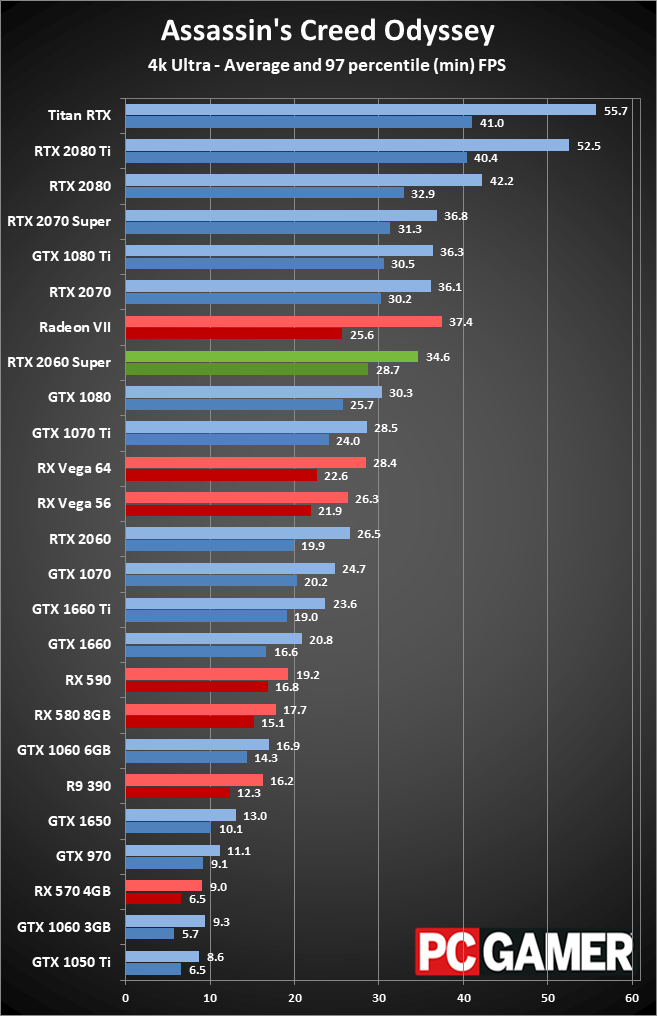
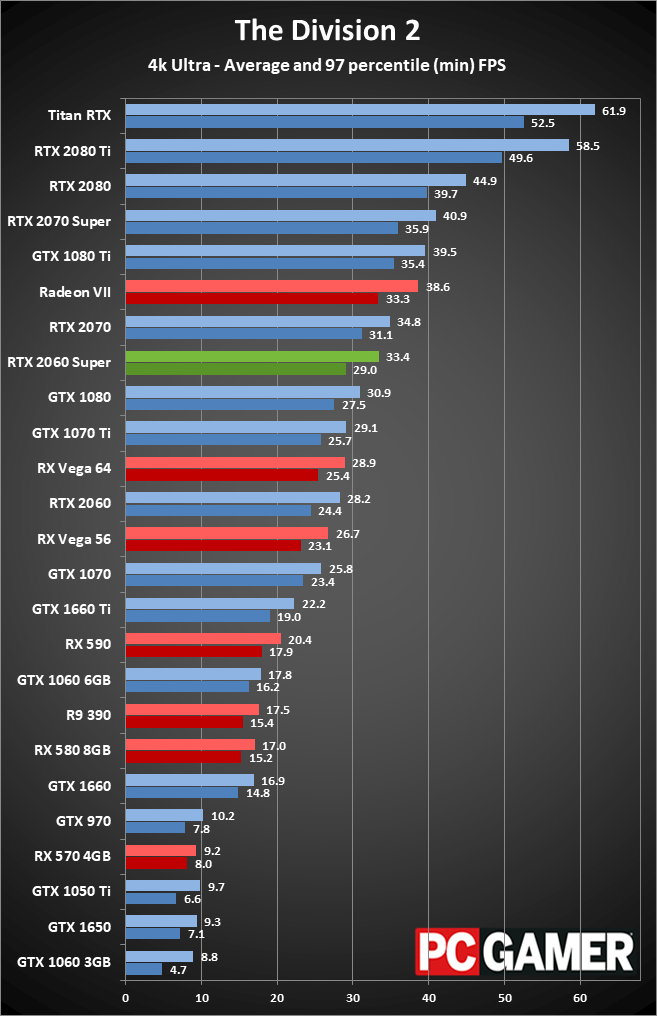
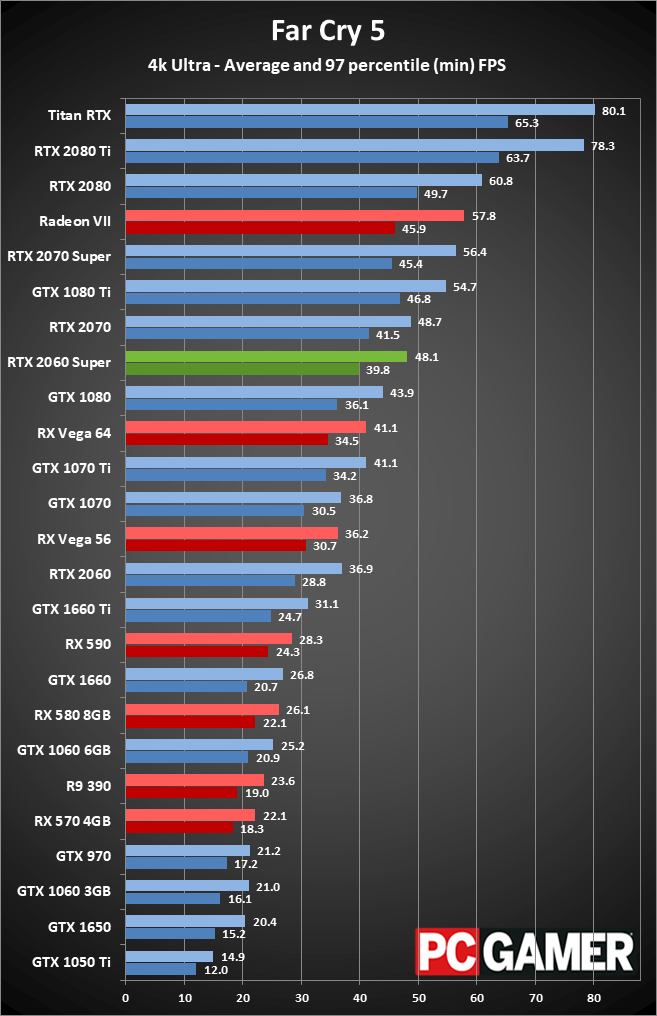
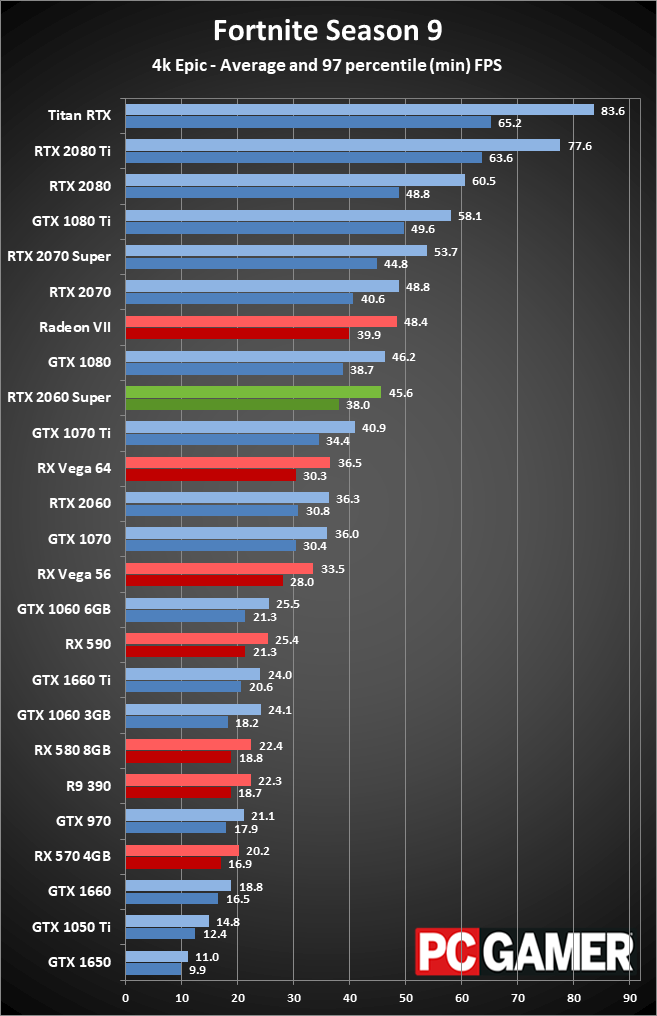
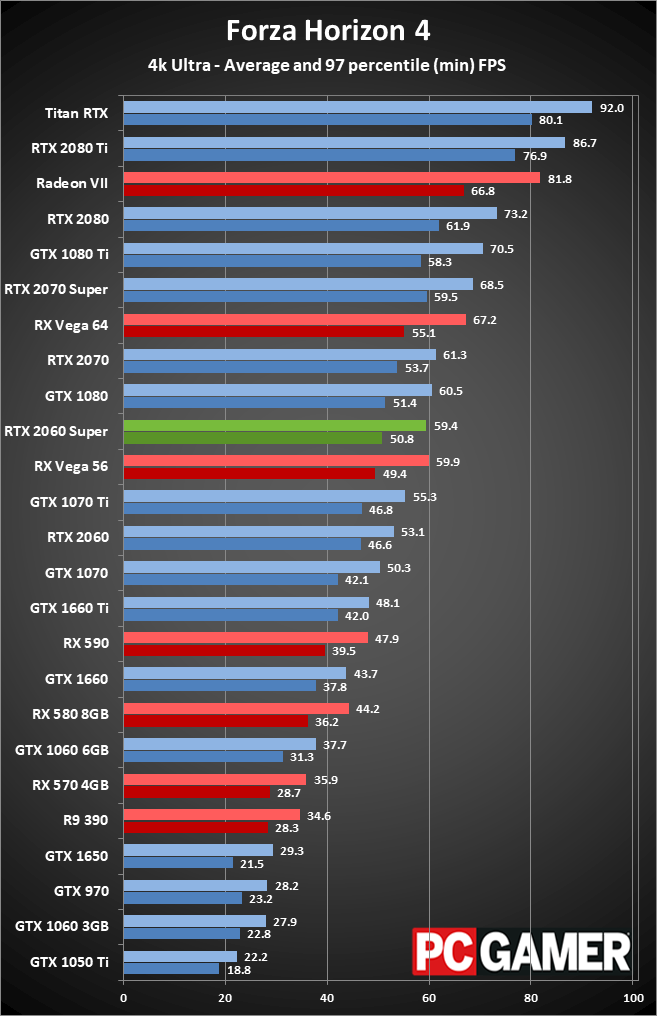
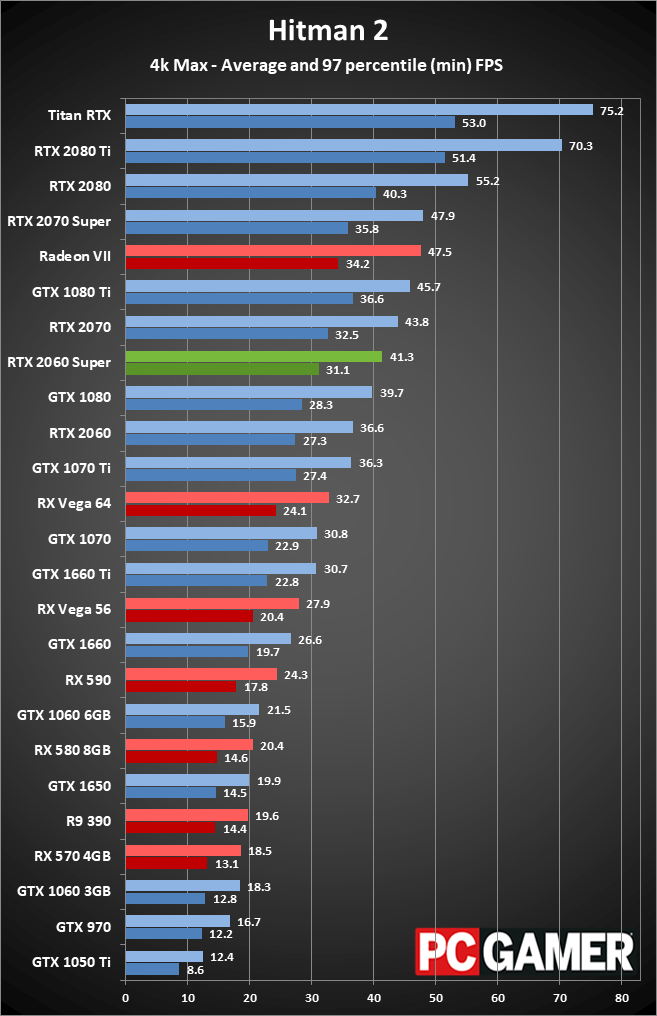
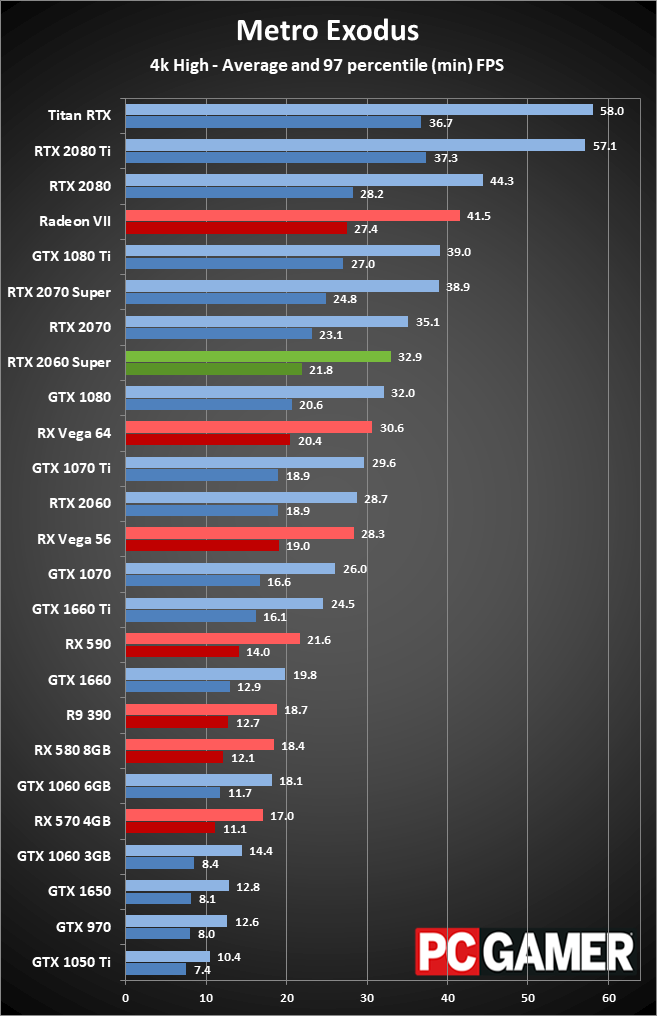
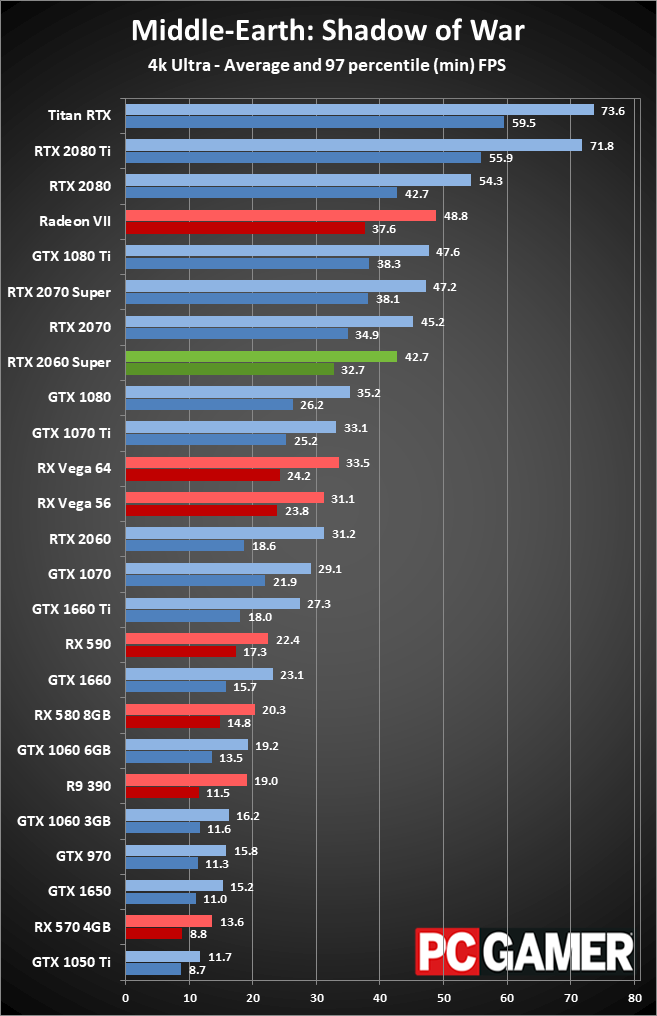
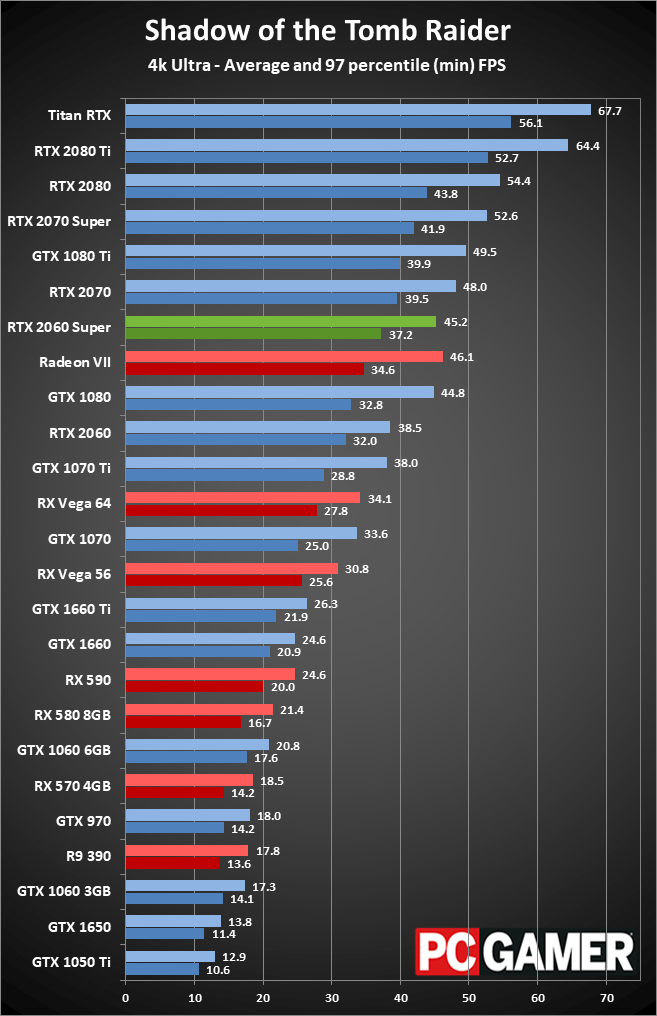
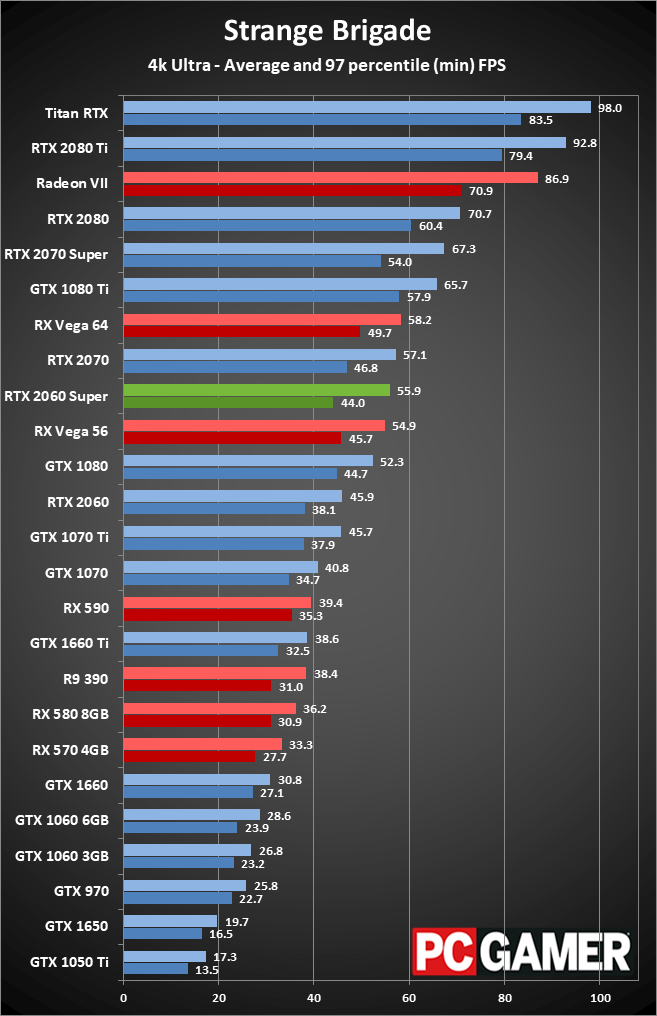
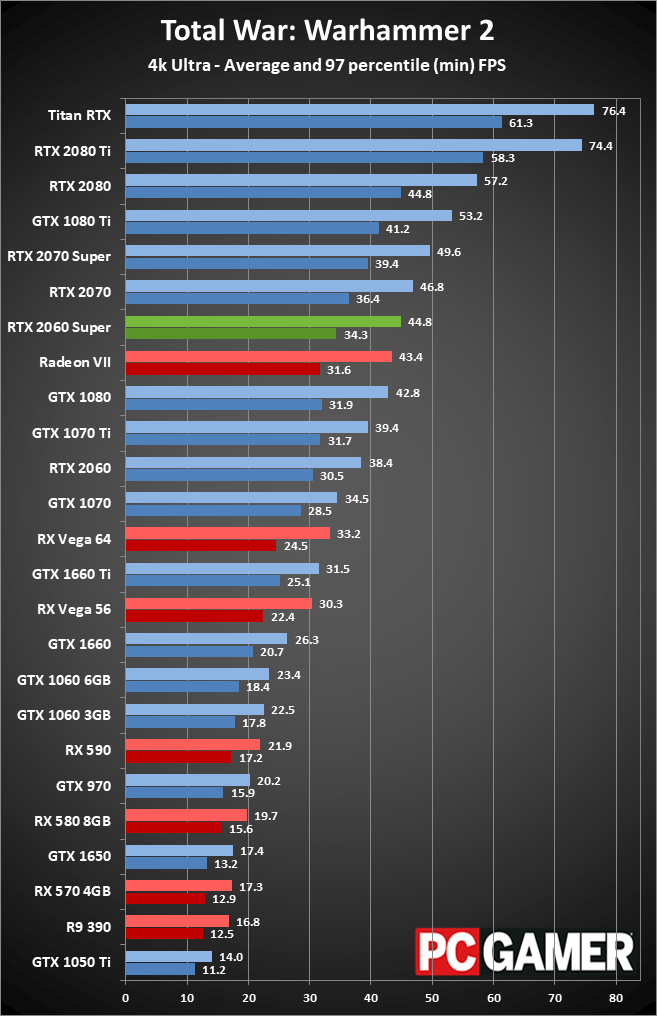
Due to time constraints and travel, we were not able to investigate overclocking in time for this initial review. I will update this section with additional details once I get a chance to catch my breath … but that probably won't be before next week, since AMD has a pile of new 7nm products all launching on July 7. Pray for me.
Finally, 4K ultra isn't generally what we recommend for the best gaming experience, since it's extremely demanding and even the fastest GPUs often come up short, but if you want to see how games several years from now might perform at 1080p ultra, it's perhaps a taste of things to come.
Average framerates across the test suite are now well below 60, and the 2070 FE continues to hold on to about a 5 percent performance lead, but the 2060 Super really blows the RTX 2060 out of the water this round, with a 21 percent overall lead. That's because games like Assassin's Creed Odyssey, Far Cry 5, Fortnite, and Shadow of War all strongly favor the additional memory bandwidth the 2060 Super provides.
GeForce RTX 2060 Super: high-end performance is now more affordable
Many felt underwhelmed by Nvidia's RTX 20-series launch—or overwhelmed by the comparatively high pricing. With no games leveraging the new ray tracing hardware at launch, and no cryptocurrency miner demand to clear inventory, sales weren't as good as Nvidia hoped. One year later, things are improving, and the 2060 Super is perhaps the best of the RTX line in terms of bang for the buck. But it's still not an awesome value if you're only looking at GPU price vs. performance—though things are better if you're looking at total system cost.
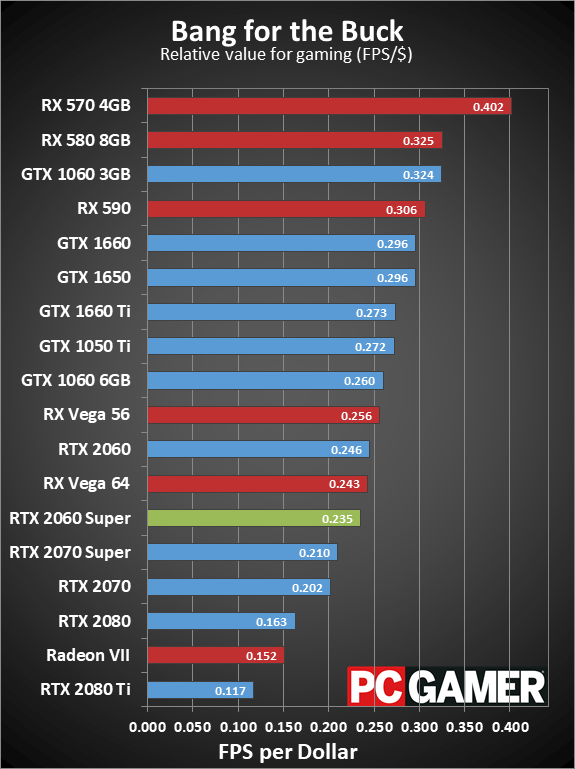
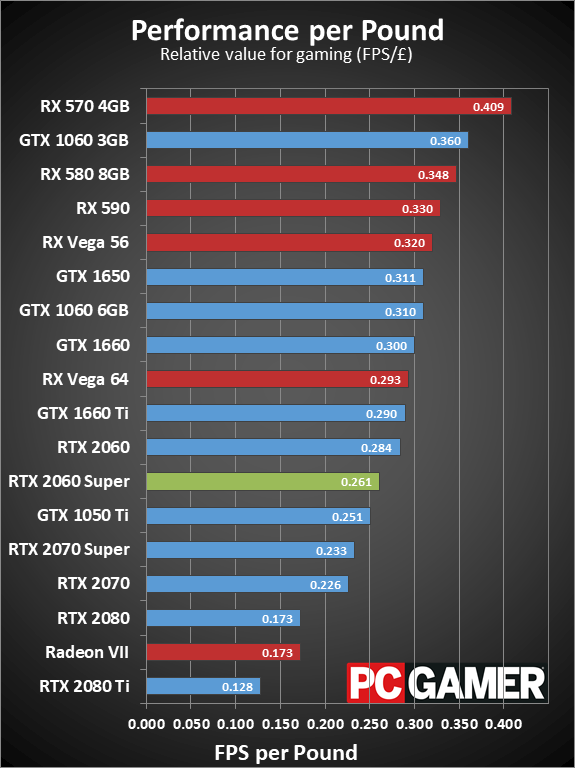
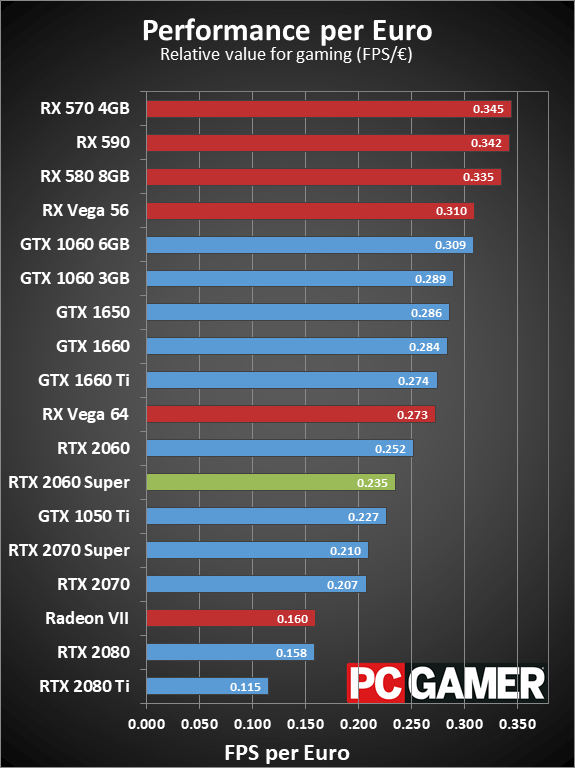
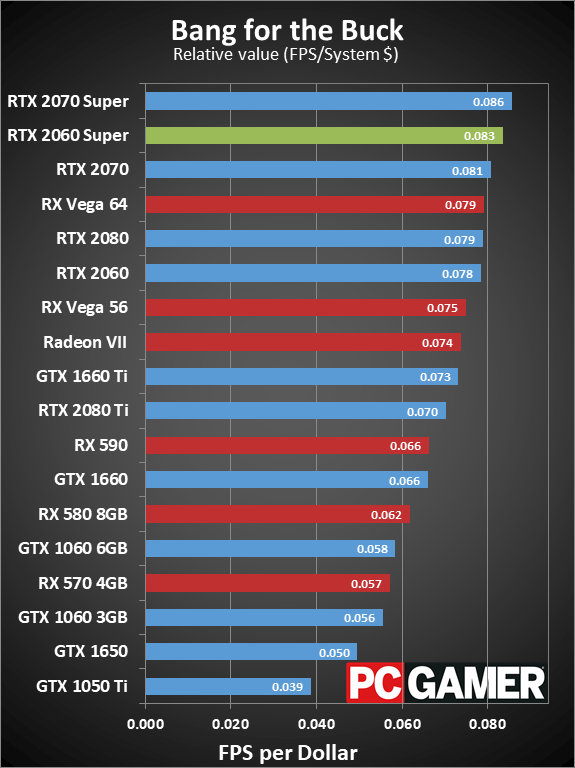
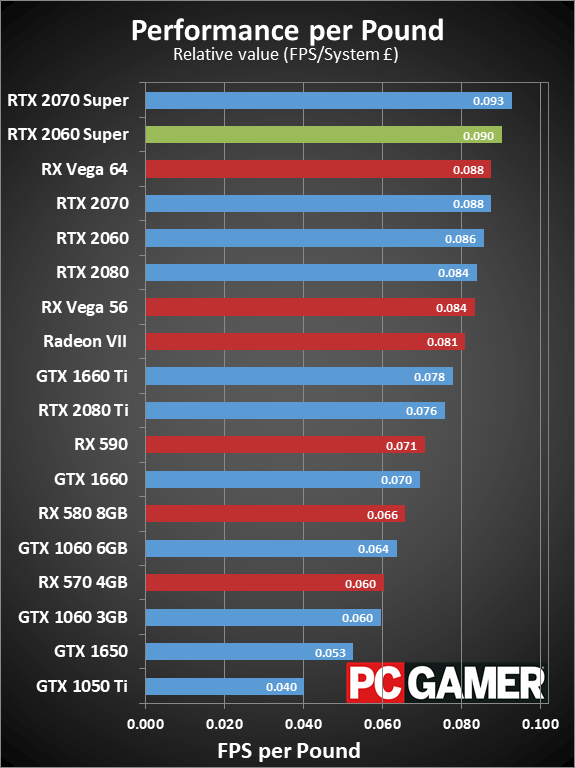
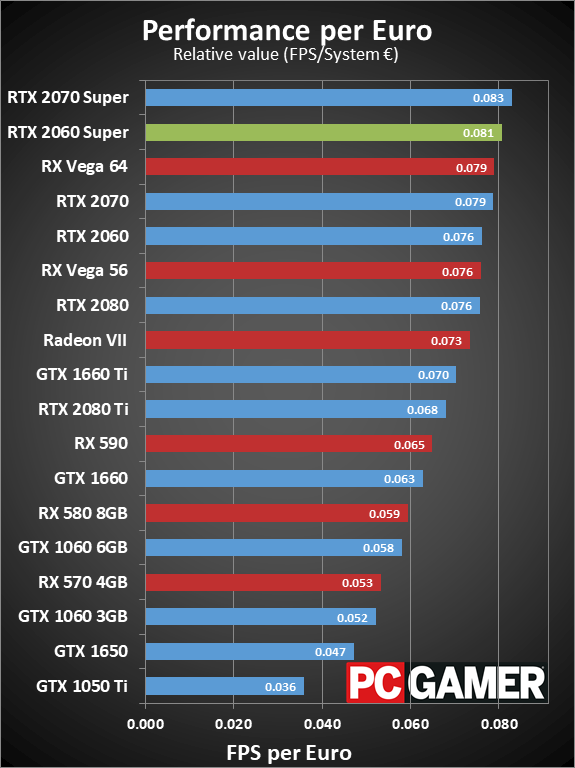
There are two ways of looking at the RTX 2060 Super, and how you ultimately feel about the new graphics card will depend on which perspective you take. One view is that it's a slightly faster card than the RTX 2060 and it costs $50 more. That's not super exciting. The other perspective is much more enticing: it's effectively replacing the RTX 2070 level of performance for $100 less. (Again, keep in mind that our performance charts use an overclocked 2070 FE, while the 2060 Super uses reference clocks.)
While cards like the RX 570 are an amazing value given their current clearance pricing, it's important to remember that the 570 is typically best when playing games at 1080p and medium or high quality. The 2060 Super may cost three times as much, but it's also nearly twice as fast, and it's far more capable of running games at higher framerates and higher resolutions.
If you haven't felt the need to jump on the ray tracing RTX bandwagon yet, the 2060 Super isn't likely to change your mind. It's arguably more a question of getting the killer ray tracing app than the hardware, though. Metro Exodus looks better with ray traced global illumination, but it still looks good without it. Until a game comes out that looks so amazing with ray tracing that everyone wants to upgrade, RTX is more of a nice extra than a must-have feature. And maybe it will remain that way for years to come.
The RTX 2060 Super is still a good card. It's faster than a GTX 1080 at a lower price, with new features that may benefit future games. We wouldn't recommend upgrading from a GTX 1080 to an RTX 2060 Super, but if you're running an older GPU and are looking to spend $300 or more on a high-end graphics card, it's a worthy pick. And it makes the prospect of buying AMD's RX 5700 series more difficult.
Check back on Sunday (July 7) and we'll see how AMD's newcomers fare against Nvidia's new Super heroes. The GeForce RTX 2060 Super and 2070 Super officially go on sale on July 9.
The GeForce RTX 2060 Super is a capable graphics card that nearly matches the performance of the RTX 2070 while shaving $100 off the price.
Jarred's love of computers dates back to the dark ages when his dad brought home a DOS 2.3 PC and he left his C-64 behind. He eventually built his first custom PC in 1990 with a 286 12MHz, only to discover it was already woefully outdated when Wing Commander was released a few months later. He holds a BS in Computer Science from Brigham Young University and has been working as a tech journalist since 2004, writing for AnandTech, Maximum PC, and PC Gamer. From the first S3 Virge '3D decelerators' to today's GPUs, Jarred keeps up with all the latest graphics trends and is the one to ask about game performance.
